MedBed Hotel Customer Service Plan
VerifiedAdded on 2020/03/01
|35
|8260
|461
AI Summary
This assignment focuses on developing a comprehensive customer service plan for MedBed Hotels. It delves into strategies for managing guest dissatisfaction, offering alternatives during service failures, and implementing service recovery processes. The plan also emphasizes the importance of both external and internal customer relationship management through technological innovation, loyalty programs, and feedback mechanisms. Additionally, it outlines a team contract and meeting log to ensure effective collaboration in achieving customer satisfaction goals.
Contribute Materials
Your contribution can guide someone’s learning journey. Share your
documents today.
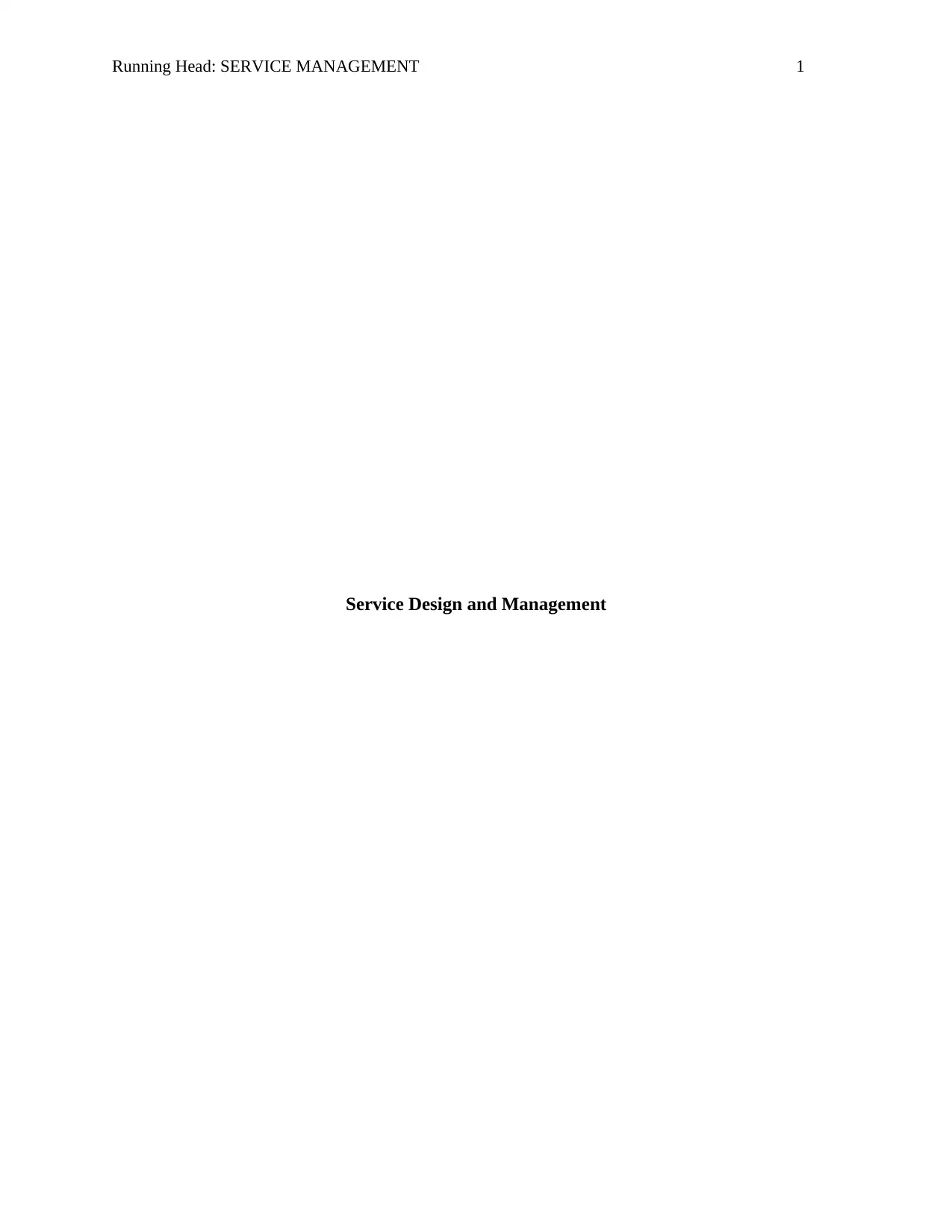
Running Head: SERVICE MANAGEMENT 1
Service Design and Management
Service Design and Management
Secure Best Marks with AI Grader
Need help grading? Try our AI Grader for instant feedback on your assignments.
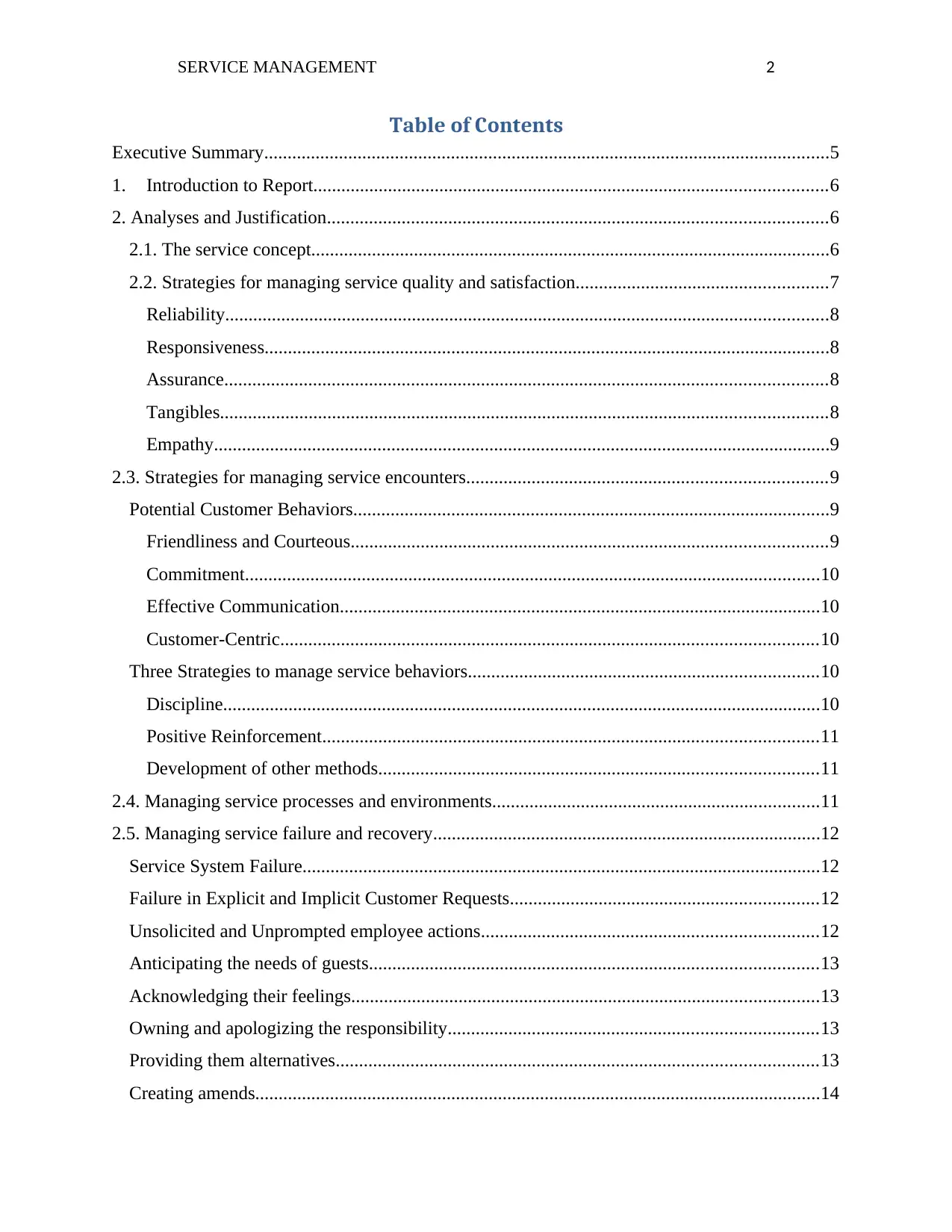
SERVICE MANAGEMENT 2
Table of Contents
Executive Summary.........................................................................................................................5
1. Introduction to Report..............................................................................................................6
2. Analyses and Justification...........................................................................................................6
2.1. The service concept...............................................................................................................6
2.2. Strategies for managing service quality and satisfaction......................................................7
Reliability.................................................................................................................................8
Responsiveness.........................................................................................................................8
Assurance.................................................................................................................................8
Tangibles..................................................................................................................................8
Empathy....................................................................................................................................9
2.3. Strategies for managing service encounters.............................................................................9
Potential Customer Behaviors......................................................................................................9
Friendliness and Courteous......................................................................................................9
Commitment...........................................................................................................................10
Effective Communication.......................................................................................................10
Customer-Centric...................................................................................................................10
Three Strategies to manage service behaviors...........................................................................10
Discipline................................................................................................................................10
Positive Reinforcement..........................................................................................................11
Development of other methods..............................................................................................11
2.4. Managing service processes and environments......................................................................11
2.5. Managing service failure and recovery...................................................................................12
Service System Failure...............................................................................................................12
Failure in Explicit and Implicit Customer Requests..................................................................12
Unsolicited and Unprompted employee actions........................................................................12
Anticipating the needs of guests................................................................................................13
Acknowledging their feelings....................................................................................................13
Owning and apologizing the responsibility...............................................................................13
Providing them alternatives.......................................................................................................13
Creating amends.........................................................................................................................14
Table of Contents
Executive Summary.........................................................................................................................5
1. Introduction to Report..............................................................................................................6
2. Analyses and Justification...........................................................................................................6
2.1. The service concept...............................................................................................................6
2.2. Strategies for managing service quality and satisfaction......................................................7
Reliability.................................................................................................................................8
Responsiveness.........................................................................................................................8
Assurance.................................................................................................................................8
Tangibles..................................................................................................................................8
Empathy....................................................................................................................................9
2.3. Strategies for managing service encounters.............................................................................9
Potential Customer Behaviors......................................................................................................9
Friendliness and Courteous......................................................................................................9
Commitment...........................................................................................................................10
Effective Communication.......................................................................................................10
Customer-Centric...................................................................................................................10
Three Strategies to manage service behaviors...........................................................................10
Discipline................................................................................................................................10
Positive Reinforcement..........................................................................................................11
Development of other methods..............................................................................................11
2.4. Managing service processes and environments......................................................................11
2.5. Managing service failure and recovery...................................................................................12
Service System Failure...............................................................................................................12
Failure in Explicit and Implicit Customer Requests..................................................................12
Unsolicited and Unprompted employee actions........................................................................12
Anticipating the needs of guests................................................................................................13
Acknowledging their feelings....................................................................................................13
Owning and apologizing the responsibility...............................................................................13
Providing them alternatives.......................................................................................................13
Creating amends.........................................................................................................................14
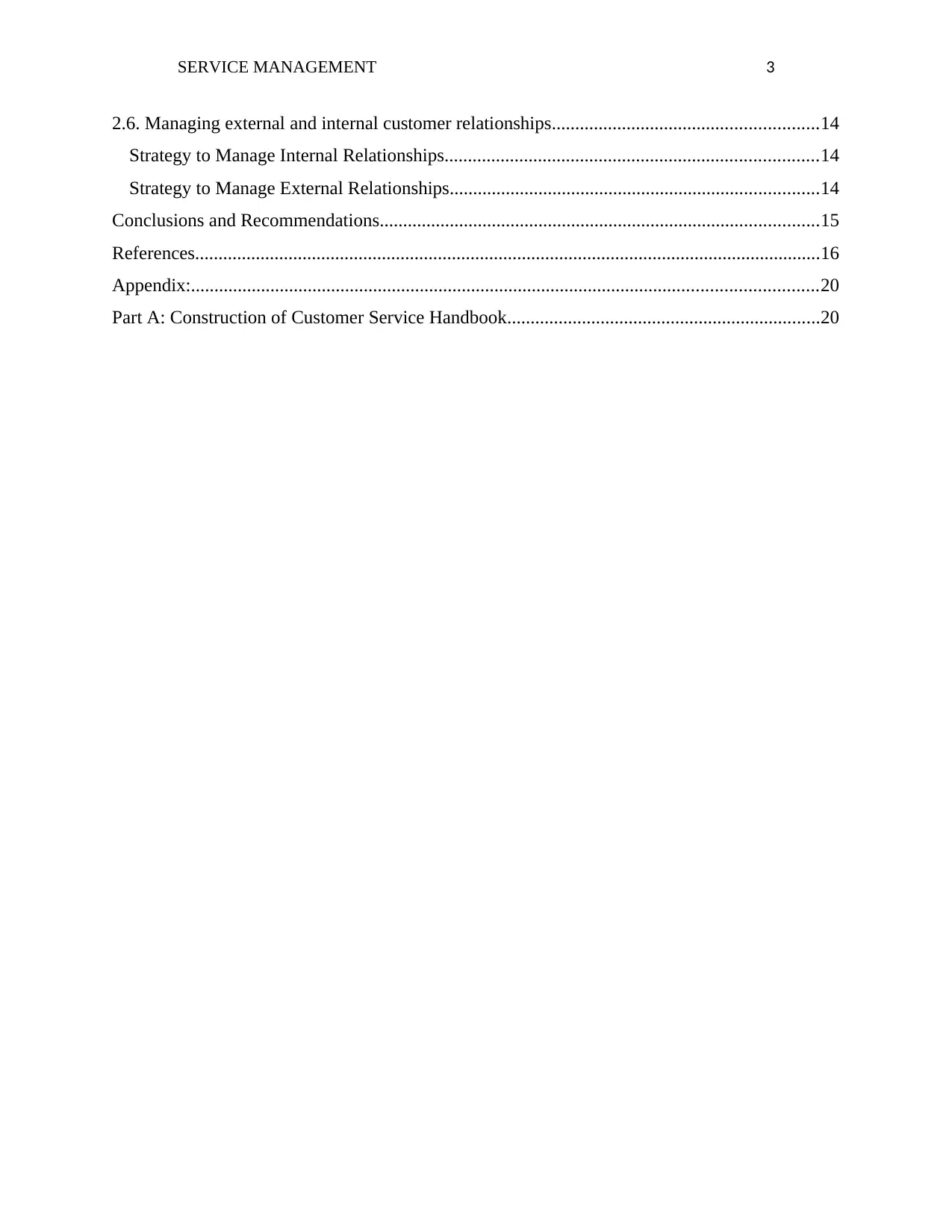
SERVICE MANAGEMENT 3
2.6. Managing external and internal customer relationships.........................................................14
Strategy to Manage Internal Relationships................................................................................14
Strategy to Manage External Relationships...............................................................................14
Conclusions and Recommendations..............................................................................................15
References......................................................................................................................................16
Appendix:......................................................................................................................................20
Part A: Construction of Customer Service Handbook...................................................................20
2.6. Managing external and internal customer relationships.........................................................14
Strategy to Manage Internal Relationships................................................................................14
Strategy to Manage External Relationships...............................................................................14
Conclusions and Recommendations..............................................................................................15
References......................................................................................................................................16
Appendix:......................................................................................................................................20
Part A: Construction of Customer Service Handbook...................................................................20
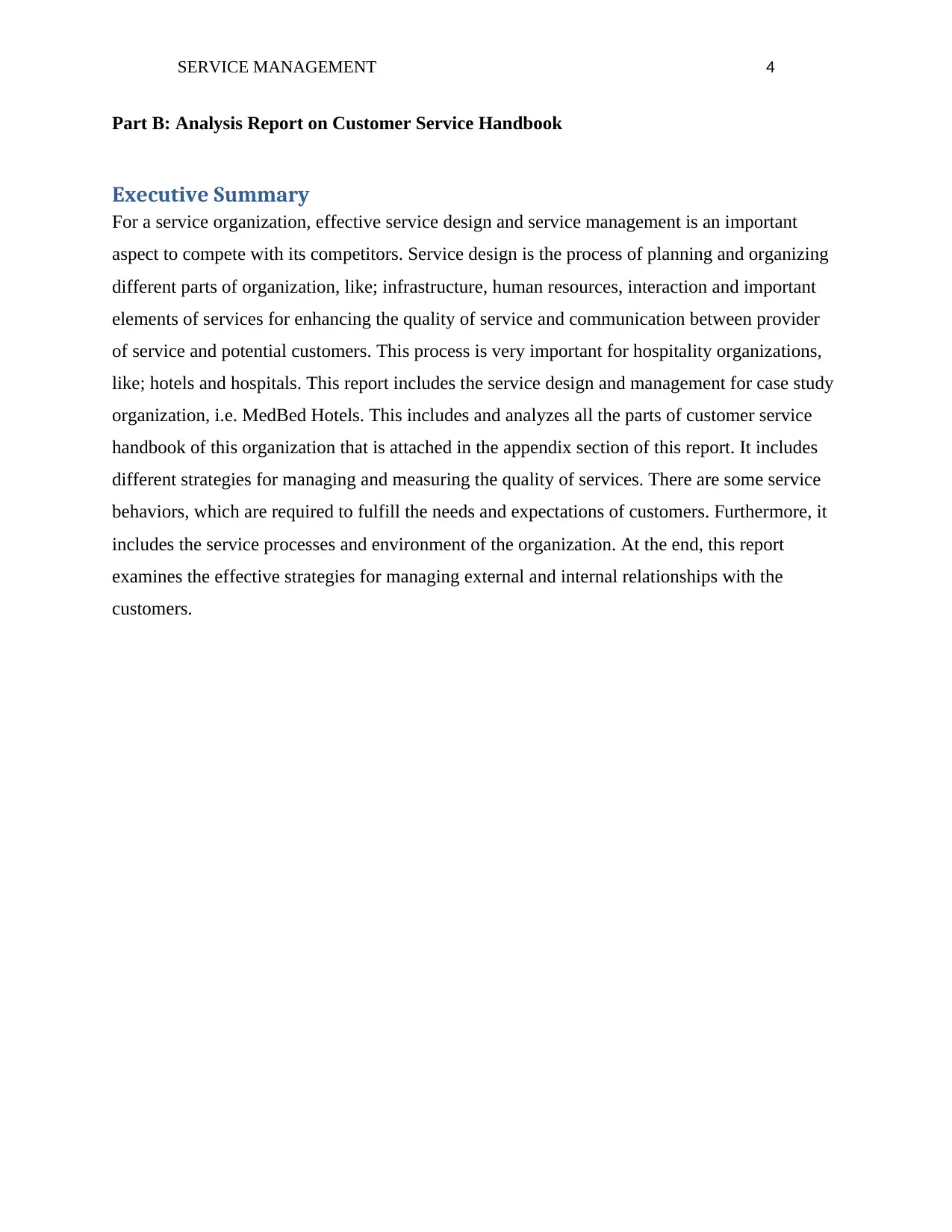
SERVICE MANAGEMENT 4
Part B: Analysis Report on Customer Service Handbook
Executive Summary
For a service organization, effective service design and service management is an important
aspect to compete with its competitors. Service design is the process of planning and organizing
different parts of organization, like; infrastructure, human resources, interaction and important
elements of services for enhancing the quality of service and communication between provider
of service and potential customers. This process is very important for hospitality organizations,
like; hotels and hospitals. This report includes the service design and management for case study
organization, i.e. MedBed Hotels. This includes and analyzes all the parts of customer service
handbook of this organization that is attached in the appendix section of this report. It includes
different strategies for managing and measuring the quality of services. There are some service
behaviors, which are required to fulfill the needs and expectations of customers. Furthermore, it
includes the service processes and environment of the organization. At the end, this report
examines the effective strategies for managing external and internal relationships with the
customers.
Part B: Analysis Report on Customer Service Handbook
Executive Summary
For a service organization, effective service design and service management is an important
aspect to compete with its competitors. Service design is the process of planning and organizing
different parts of organization, like; infrastructure, human resources, interaction and important
elements of services for enhancing the quality of service and communication between provider
of service and potential customers. This process is very important for hospitality organizations,
like; hotels and hospitals. This report includes the service design and management for case study
organization, i.e. MedBed Hotels. This includes and analyzes all the parts of customer service
handbook of this organization that is attached in the appendix section of this report. It includes
different strategies for managing and measuring the quality of services. There are some service
behaviors, which are required to fulfill the needs and expectations of customers. Furthermore, it
includes the service processes and environment of the organization. At the end, this report
examines the effective strategies for managing external and internal relationships with the
customers.
Secure Best Marks with AI Grader
Need help grading? Try our AI Grader for instant feedback on your assignments.
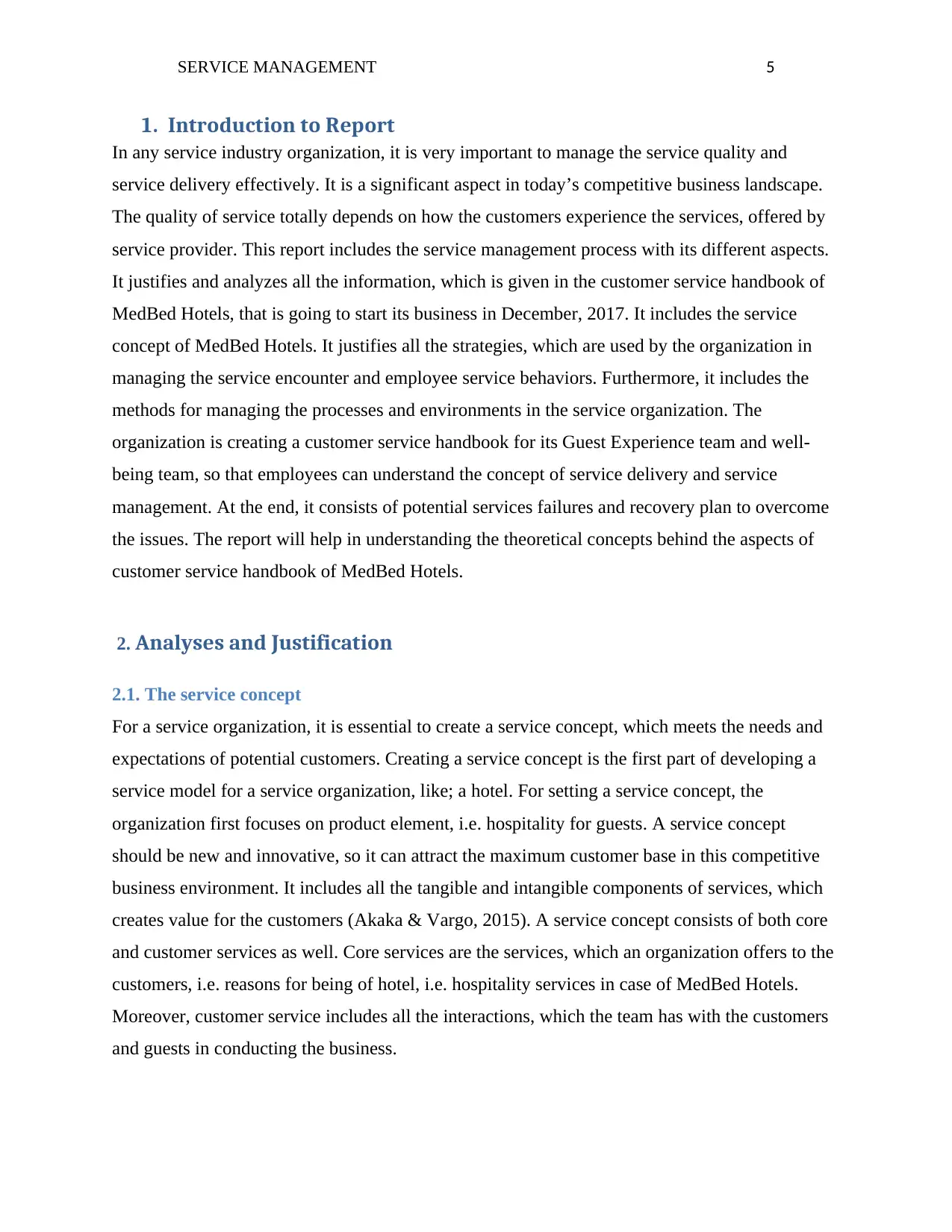
SERVICE MANAGEMENT 5
1. Introduction to Report
In any service industry organization, it is very important to manage the service quality and
service delivery effectively. It is a significant aspect in today’s competitive business landscape.
The quality of service totally depends on how the customers experience the services, offered by
service provider. This report includes the service management process with its different aspects.
It justifies and analyzes all the information, which is given in the customer service handbook of
MedBed Hotels, that is going to start its business in December, 2017. It includes the service
concept of MedBed Hotels. It justifies all the strategies, which are used by the organization in
managing the service encounter and employee service behaviors. Furthermore, it includes the
methods for managing the processes and environments in the service organization. The
organization is creating a customer service handbook for its Guest Experience team and well-
being team, so that employees can understand the concept of service delivery and service
management. At the end, it consists of potential services failures and recovery plan to overcome
the issues. The report will help in understanding the theoretical concepts behind the aspects of
customer service handbook of MedBed Hotels.
2. Analyses and Justification
2.1. The service concept
For a service organization, it is essential to create a service concept, which meets the needs and
expectations of potential customers. Creating a service concept is the first part of developing a
service model for a service organization, like; a hotel. For setting a service concept, the
organization first focuses on product element, i.e. hospitality for guests. A service concept
should be new and innovative, so it can attract the maximum customer base in this competitive
business environment. It includes all the tangible and intangible components of services, which
creates value for the customers (Akaka & Vargo, 2015). A service concept consists of both core
and customer services as well. Core services are the services, which an organization offers to the
customers, i.e. reasons for being of hotel, i.e. hospitality services in case of MedBed Hotels.
Moreover, customer service includes all the interactions, which the team has with the customers
and guests in conducting the business.
1. Introduction to Report
In any service industry organization, it is very important to manage the service quality and
service delivery effectively. It is a significant aspect in today’s competitive business landscape.
The quality of service totally depends on how the customers experience the services, offered by
service provider. This report includes the service management process with its different aspects.
It justifies and analyzes all the information, which is given in the customer service handbook of
MedBed Hotels, that is going to start its business in December, 2017. It includes the service
concept of MedBed Hotels. It justifies all the strategies, which are used by the organization in
managing the service encounter and employee service behaviors. Furthermore, it includes the
methods for managing the processes and environments in the service organization. The
organization is creating a customer service handbook for its Guest Experience team and well-
being team, so that employees can understand the concept of service delivery and service
management. At the end, it consists of potential services failures and recovery plan to overcome
the issues. The report will help in understanding the theoretical concepts behind the aspects of
customer service handbook of MedBed Hotels.
2. Analyses and Justification
2.1. The service concept
For a service organization, it is essential to create a service concept, which meets the needs and
expectations of potential customers. Creating a service concept is the first part of developing a
service model for a service organization, like; a hotel. For setting a service concept, the
organization first focuses on product element, i.e. hospitality for guests. A service concept
should be new and innovative, so it can attract the maximum customer base in this competitive
business environment. It includes all the tangible and intangible components of services, which
creates value for the customers (Akaka & Vargo, 2015). A service concept consists of both core
and customer services as well. Core services are the services, which an organization offers to the
customers, i.e. reasons for being of hotel, i.e. hospitality services in case of MedBed Hotels.
Moreover, customer service includes all the interactions, which the team has with the customers
and guests in conducting the business.
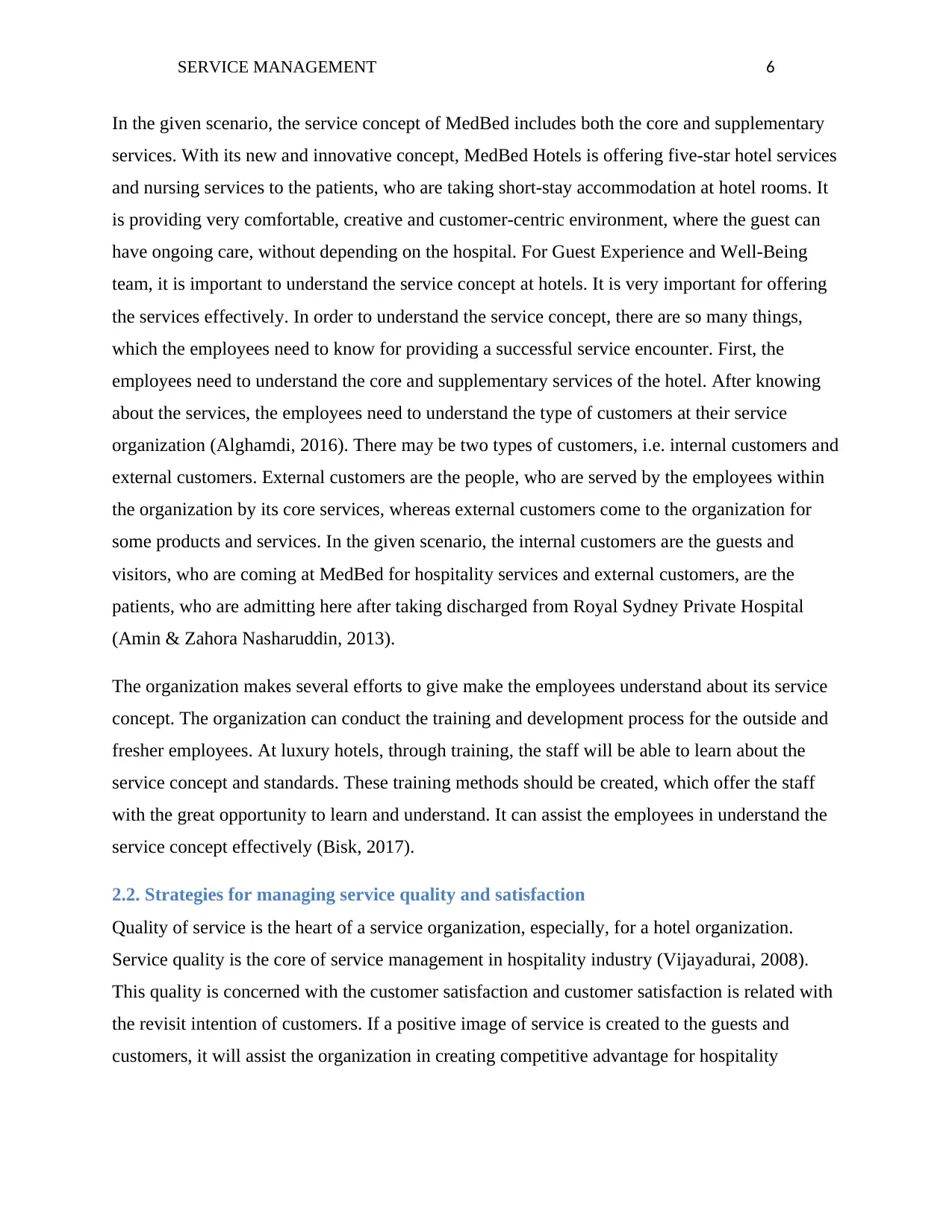
SERVICE MANAGEMENT 6
In the given scenario, the service concept of MedBed includes both the core and supplementary
services. With its new and innovative concept, MedBed Hotels is offering five-star hotel services
and nursing services to the patients, who are taking short-stay accommodation at hotel rooms. It
is providing very comfortable, creative and customer-centric environment, where the guest can
have ongoing care, without depending on the hospital. For Guest Experience and Well-Being
team, it is important to understand the service concept at hotels. It is very important for offering
the services effectively. In order to understand the service concept, there are so many things,
which the employees need to know for providing a successful service encounter. First, the
employees need to understand the core and supplementary services of the hotel. After knowing
about the services, the employees need to understand the type of customers at their service
organization (Alghamdi, 2016). There may be two types of customers, i.e. internal customers and
external customers. External customers are the people, who are served by the employees within
the organization by its core services, whereas external customers come to the organization for
some products and services. In the given scenario, the internal customers are the guests and
visitors, who are coming at MedBed for hospitality services and external customers, are the
patients, who are admitting here after taking discharged from Royal Sydney Private Hospital
(Amin & Zahora Nasharuddin, 2013).
The organization makes several efforts to give make the employees understand about its service
concept. The organization can conduct the training and development process for the outside and
fresher employees. At luxury hotels, through training, the staff will be able to learn about the
service concept and standards. These training methods should be created, which offer the staff
with the great opportunity to learn and understand. It can assist the employees in understand the
service concept effectively (Bisk, 2017).
2.2. Strategies for managing service quality and satisfaction
Quality of service is the heart of a service organization, especially, for a hotel organization.
Service quality is the core of service management in hospitality industry (Vijayadurai, 2008).
This quality is concerned with the customer satisfaction and customer satisfaction is related with
the revisit intention of customers. If a positive image of service is created to the guests and
customers, it will assist the organization in creating competitive advantage for hospitality
In the given scenario, the service concept of MedBed includes both the core and supplementary
services. With its new and innovative concept, MedBed Hotels is offering five-star hotel services
and nursing services to the patients, who are taking short-stay accommodation at hotel rooms. It
is providing very comfortable, creative and customer-centric environment, where the guest can
have ongoing care, without depending on the hospital. For Guest Experience and Well-Being
team, it is important to understand the service concept at hotels. It is very important for offering
the services effectively. In order to understand the service concept, there are so many things,
which the employees need to know for providing a successful service encounter. First, the
employees need to understand the core and supplementary services of the hotel. After knowing
about the services, the employees need to understand the type of customers at their service
organization (Alghamdi, 2016). There may be two types of customers, i.e. internal customers and
external customers. External customers are the people, who are served by the employees within
the organization by its core services, whereas external customers come to the organization for
some products and services. In the given scenario, the internal customers are the guests and
visitors, who are coming at MedBed for hospitality services and external customers, are the
patients, who are admitting here after taking discharged from Royal Sydney Private Hospital
(Amin & Zahora Nasharuddin, 2013).
The organization makes several efforts to give make the employees understand about its service
concept. The organization can conduct the training and development process for the outside and
fresher employees. At luxury hotels, through training, the staff will be able to learn about the
service concept and standards. These training methods should be created, which offer the staff
with the great opportunity to learn and understand. It can assist the employees in understand the
service concept effectively (Bisk, 2017).
2.2. Strategies for managing service quality and satisfaction
Quality of service is the heart of a service organization, especially, for a hotel organization.
Service quality is the core of service management in hospitality industry (Vijayadurai, 2008).
This quality is concerned with the customer satisfaction and customer satisfaction is related with
the revisit intention of customers. If a positive image of service is created to the guests and
customers, it will assist the organization in creating competitive advantage for hospitality
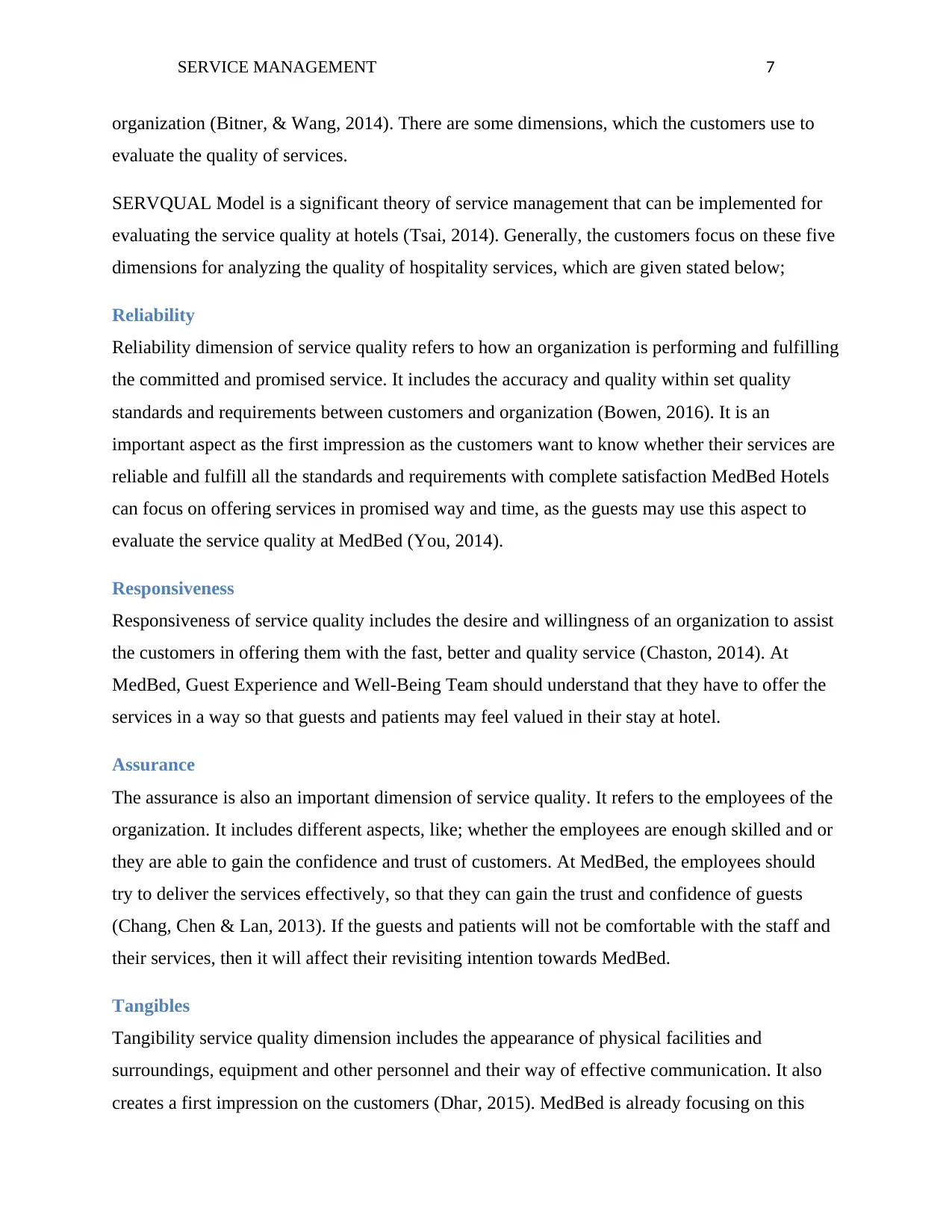
SERVICE MANAGEMENT 7
organization (Bitner, & Wang, 2014). There are some dimensions, which the customers use to
evaluate the quality of services.
SERVQUAL Model is a significant theory of service management that can be implemented for
evaluating the service quality at hotels (Tsai, 2014). Generally, the customers focus on these five
dimensions for analyzing the quality of hospitality services, which are given stated below;
Reliability
Reliability dimension of service quality refers to how an organization is performing and fulfilling
the committed and promised service. It includes the accuracy and quality within set quality
standards and requirements between customers and organization (Bowen, 2016). It is an
important aspect as the first impression as the customers want to know whether their services are
reliable and fulfill all the standards and requirements with complete satisfaction MedBed Hotels
can focus on offering services in promised way and time, as the guests may use this aspect to
evaluate the service quality at MedBed (You, 2014).
Responsiveness
Responsiveness of service quality includes the desire and willingness of an organization to assist
the customers in offering them with the fast, better and quality service (Chaston, 2014). At
MedBed, Guest Experience and Well-Being Team should understand that they have to offer the
services in a way so that guests and patients may feel valued in their stay at hotel.
Assurance
The assurance is also an important dimension of service quality. It refers to the employees of the
organization. It includes different aspects, like; whether the employees are enough skilled and or
they are able to gain the confidence and trust of customers. At MedBed, the employees should
try to deliver the services effectively, so that they can gain the trust and confidence of guests
(Chang, Chen & Lan, 2013). If the guests and patients will not be comfortable with the staff and
their services, then it will affect their revisiting intention towards MedBed.
Tangibles
Tangibility service quality dimension includes the appearance of physical facilities and
surroundings, equipment and other personnel and their way of effective communication. It also
creates a first impression on the customers (Dhar, 2015). MedBed is already focusing on this
organization (Bitner, & Wang, 2014). There are some dimensions, which the customers use to
evaluate the quality of services.
SERVQUAL Model is a significant theory of service management that can be implemented for
evaluating the service quality at hotels (Tsai, 2014). Generally, the customers focus on these five
dimensions for analyzing the quality of hospitality services, which are given stated below;
Reliability
Reliability dimension of service quality refers to how an organization is performing and fulfilling
the committed and promised service. It includes the accuracy and quality within set quality
standards and requirements between customers and organization (Bowen, 2016). It is an
important aspect as the first impression as the customers want to know whether their services are
reliable and fulfill all the standards and requirements with complete satisfaction MedBed Hotels
can focus on offering services in promised way and time, as the guests may use this aspect to
evaluate the service quality at MedBed (You, 2014).
Responsiveness
Responsiveness of service quality includes the desire and willingness of an organization to assist
the customers in offering them with the fast, better and quality service (Chaston, 2014). At
MedBed, Guest Experience and Well-Being Team should understand that they have to offer the
services in a way so that guests and patients may feel valued in their stay at hotel.
Assurance
The assurance is also an important dimension of service quality. It refers to the employees of the
organization. It includes different aspects, like; whether the employees are enough skilled and or
they are able to gain the confidence and trust of customers. At MedBed, the employees should
try to deliver the services effectively, so that they can gain the trust and confidence of guests
(Chang, Chen & Lan, 2013). If the guests and patients will not be comfortable with the staff and
their services, then it will affect their revisiting intention towards MedBed.
Tangibles
Tangibility service quality dimension includes the appearance of physical facilities and
surroundings, equipment and other personnel and their way of effective communication. It also
creates a first impression on the customers (Dhar, 2015). MedBed is already focusing on this
Paraphrase This Document
Need a fresh take? Get an instant paraphrase of this document with our AI Paraphraser
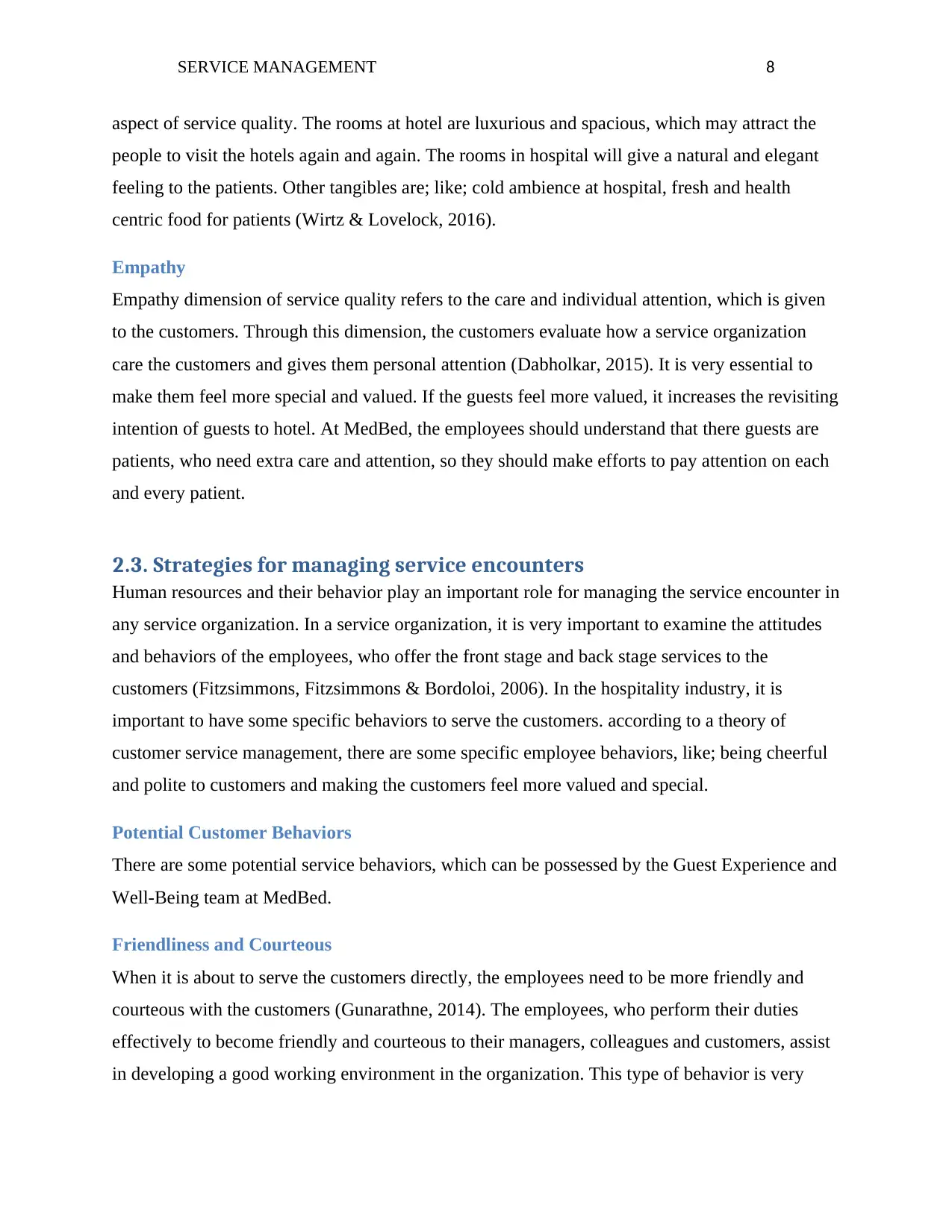
SERVICE MANAGEMENT 8
aspect of service quality. The rooms at hotel are luxurious and spacious, which may attract the
people to visit the hotels again and again. The rooms in hospital will give a natural and elegant
feeling to the patients. Other tangibles are; like; cold ambience at hospital, fresh and health
centric food for patients (Wirtz & Lovelock, 2016).
Empathy
Empathy dimension of service quality refers to the care and individual attention, which is given
to the customers. Through this dimension, the customers evaluate how a service organization
care the customers and gives them personal attention (Dabholkar, 2015). It is very essential to
make them feel more special and valued. If the guests feel more valued, it increases the revisiting
intention of guests to hotel. At MedBed, the employees should understand that there guests are
patients, who need extra care and attention, so they should make efforts to pay attention on each
and every patient.
2.3. Strategies for managing service encounters
Human resources and their behavior play an important role for managing the service encounter in
any service organization. In a service organization, it is very important to examine the attitudes
and behaviors of the employees, who offer the front stage and back stage services to the
customers (Fitzsimmons, Fitzsimmons & Bordoloi, 2006). In the hospitality industry, it is
important to have some specific behaviors to serve the customers. according to a theory of
customer service management, there are some specific employee behaviors, like; being cheerful
and polite to customers and making the customers feel more valued and special.
Potential Customer Behaviors
There are some potential service behaviors, which can be possessed by the Guest Experience and
Well-Being team at MedBed.
Friendliness and Courteous
When it is about to serve the customers directly, the employees need to be more friendly and
courteous with the customers (Gunarathne, 2014). The employees, who perform their duties
effectively to become friendly and courteous to their managers, colleagues and customers, assist
in developing a good working environment in the organization. This type of behavior is very
aspect of service quality. The rooms at hotel are luxurious and spacious, which may attract the
people to visit the hotels again and again. The rooms in hospital will give a natural and elegant
feeling to the patients. Other tangibles are; like; cold ambience at hospital, fresh and health
centric food for patients (Wirtz & Lovelock, 2016).
Empathy
Empathy dimension of service quality refers to the care and individual attention, which is given
to the customers. Through this dimension, the customers evaluate how a service organization
care the customers and gives them personal attention (Dabholkar, 2015). It is very essential to
make them feel more special and valued. If the guests feel more valued, it increases the revisiting
intention of guests to hotel. At MedBed, the employees should understand that there guests are
patients, who need extra care and attention, so they should make efforts to pay attention on each
and every patient.
2.3. Strategies for managing service encounters
Human resources and their behavior play an important role for managing the service encounter in
any service organization. In a service organization, it is very important to examine the attitudes
and behaviors of the employees, who offer the front stage and back stage services to the
customers (Fitzsimmons, Fitzsimmons & Bordoloi, 2006). In the hospitality industry, it is
important to have some specific behaviors to serve the customers. according to a theory of
customer service management, there are some specific employee behaviors, like; being cheerful
and polite to customers and making the customers feel more valued and special.
Potential Customer Behaviors
There are some potential service behaviors, which can be possessed by the Guest Experience and
Well-Being team at MedBed.
Friendliness and Courteous
When it is about to serve the customers directly, the employees need to be more friendly and
courteous with the customers (Gunarathne, 2014). The employees, who perform their duties
effectively to become friendly and courteous to their managers, colleagues and customers, assist
in developing a good working environment in the organization. This type of behavior is very
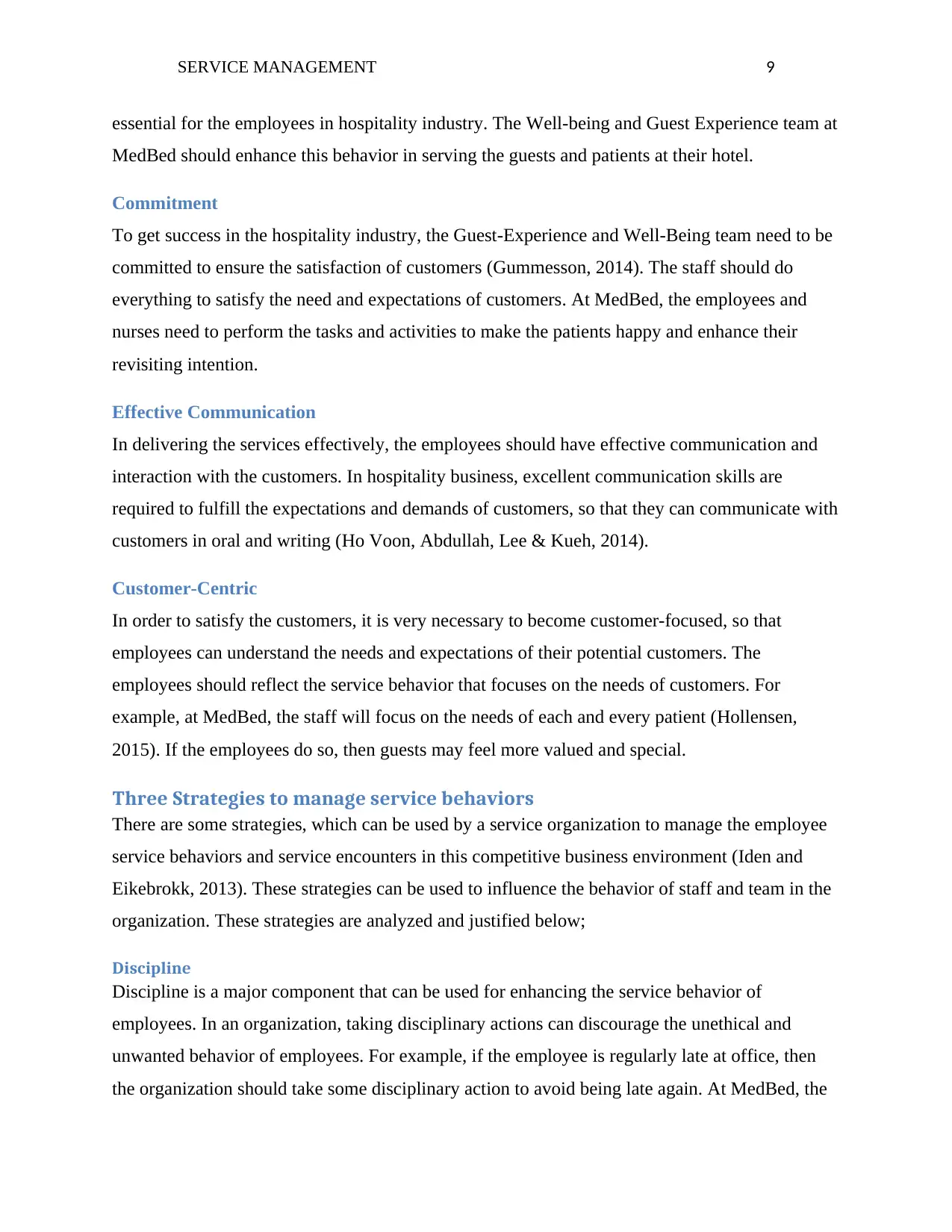
SERVICE MANAGEMENT 9
essential for the employees in hospitality industry. The Well-being and Guest Experience team at
MedBed should enhance this behavior in serving the guests and patients at their hotel.
Commitment
To get success in the hospitality industry, the Guest-Experience and Well-Being team need to be
committed to ensure the satisfaction of customers (Gummesson, 2014). The staff should do
everything to satisfy the need and expectations of customers. At MedBed, the employees and
nurses need to perform the tasks and activities to make the patients happy and enhance their
revisiting intention.
Effective Communication
In delivering the services effectively, the employees should have effective communication and
interaction with the customers. In hospitality business, excellent communication skills are
required to fulfill the expectations and demands of customers, so that they can communicate with
customers in oral and writing (Ho Voon, Abdullah, Lee & Kueh, 2014).
Customer-Centric
In order to satisfy the customers, it is very necessary to become customer-focused, so that
employees can understand the needs and expectations of their potential customers. The
employees should reflect the service behavior that focuses on the needs of customers. For
example, at MedBed, the staff will focus on the needs of each and every patient (Hollensen,
2015). If the employees do so, then guests may feel more valued and special.
Three Strategies to manage service behaviors
There are some strategies, which can be used by a service organization to manage the employee
service behaviors and service encounters in this competitive business environment (Iden and
Eikebrokk, 2013). These strategies can be used to influence the behavior of staff and team in the
organization. These strategies are analyzed and justified below;
Discipline
Discipline is a major component that can be used for enhancing the service behavior of
employees. In an organization, taking disciplinary actions can discourage the unethical and
unwanted behavior of employees. For example, if the employee is regularly late at office, then
the organization should take some disciplinary action to avoid being late again. At MedBed, the
essential for the employees in hospitality industry. The Well-being and Guest Experience team at
MedBed should enhance this behavior in serving the guests and patients at their hotel.
Commitment
To get success in the hospitality industry, the Guest-Experience and Well-Being team need to be
committed to ensure the satisfaction of customers (Gummesson, 2014). The staff should do
everything to satisfy the need and expectations of customers. At MedBed, the employees and
nurses need to perform the tasks and activities to make the patients happy and enhance their
revisiting intention.
Effective Communication
In delivering the services effectively, the employees should have effective communication and
interaction with the customers. In hospitality business, excellent communication skills are
required to fulfill the expectations and demands of customers, so that they can communicate with
customers in oral and writing (Ho Voon, Abdullah, Lee & Kueh, 2014).
Customer-Centric
In order to satisfy the customers, it is very necessary to become customer-focused, so that
employees can understand the needs and expectations of their potential customers. The
employees should reflect the service behavior that focuses on the needs of customers. For
example, at MedBed, the staff will focus on the needs of each and every patient (Hollensen,
2015). If the employees do so, then guests may feel more valued and special.
Three Strategies to manage service behaviors
There are some strategies, which can be used by a service organization to manage the employee
service behaviors and service encounters in this competitive business environment (Iden and
Eikebrokk, 2013). These strategies can be used to influence the behavior of staff and team in the
organization. These strategies are analyzed and justified below;
Discipline
Discipline is a major component that can be used for enhancing the service behavior of
employees. In an organization, taking disciplinary actions can discourage the unethical and
unwanted behavior of employees. For example, if the employee is regularly late at office, then
the organization should take some disciplinary action to avoid being late again. At MedBed, the
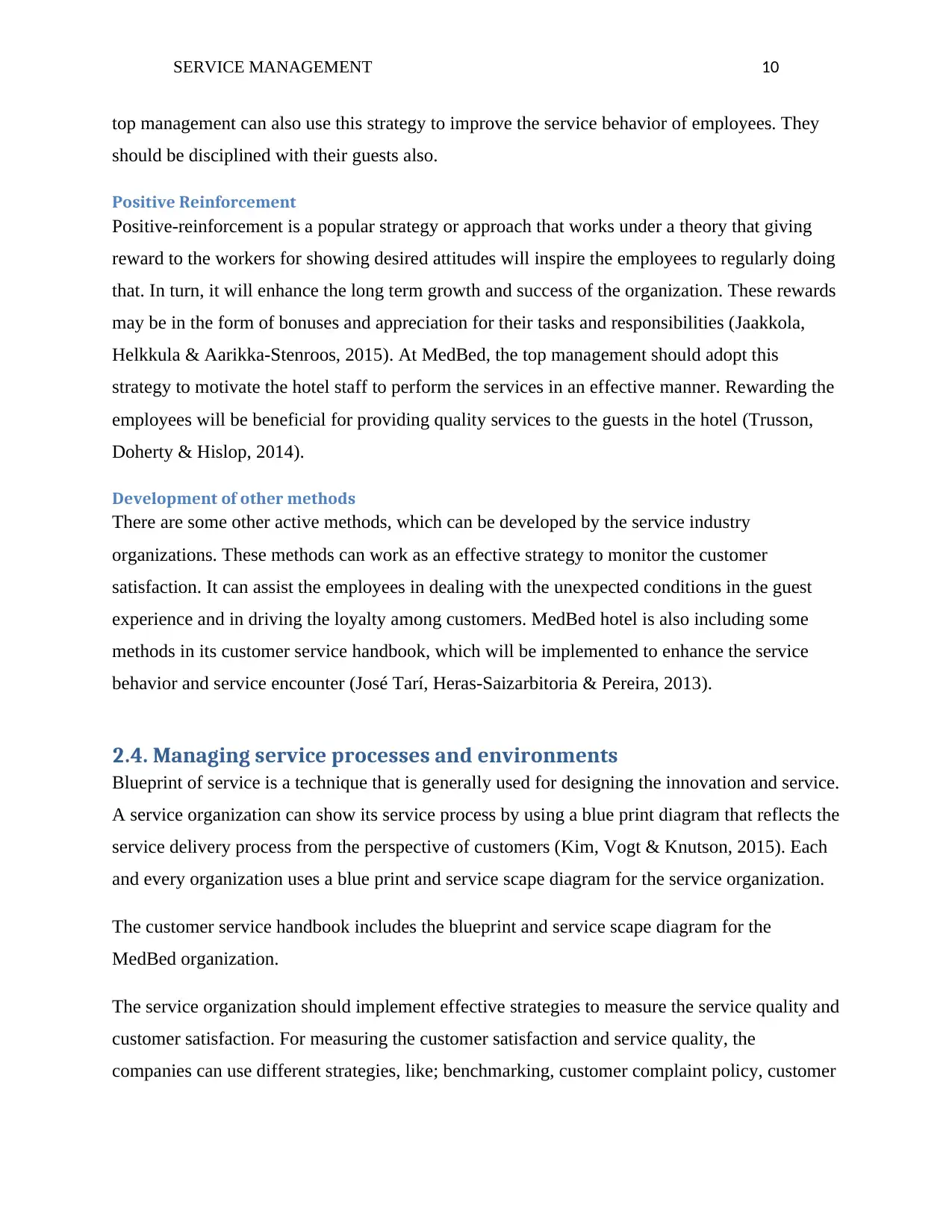
SERVICE MANAGEMENT 10
top management can also use this strategy to improve the service behavior of employees. They
should be disciplined with their guests also.
Positive Reinforcement
Positive-reinforcement is a popular strategy or approach that works under a theory that giving
reward to the workers for showing desired attitudes will inspire the employees to regularly doing
that. In turn, it will enhance the long term growth and success of the organization. These rewards
may be in the form of bonuses and appreciation for their tasks and responsibilities (Jaakkola,
Helkkula & Aarikka-Stenroos, 2015). At MedBed, the top management should adopt this
strategy to motivate the hotel staff to perform the services in an effective manner. Rewarding the
employees will be beneficial for providing quality services to the guests in the hotel (Trusson,
Doherty & Hislop, 2014).
Development of other methods
There are some other active methods, which can be developed by the service industry
organizations. These methods can work as an effective strategy to monitor the customer
satisfaction. It can assist the employees in dealing with the unexpected conditions in the guest
experience and in driving the loyalty among customers. MedBed hotel is also including some
methods in its customer service handbook, which will be implemented to enhance the service
behavior and service encounter (José Tarí, Heras-Saizarbitoria & Pereira, 2013).
2.4. Managing service processes and environments
Blueprint of service is a technique that is generally used for designing the innovation and service.
A service organization can show its service process by using a blue print diagram that reflects the
service delivery process from the perspective of customers (Kim, Vogt & Knutson, 2015). Each
and every organization uses a blue print and service scape diagram for the service organization.
The customer service handbook includes the blueprint and service scape diagram for the
MedBed organization.
The service organization should implement effective strategies to measure the service quality and
customer satisfaction. For measuring the customer satisfaction and service quality, the
companies can use different strategies, like; benchmarking, customer complaint policy, customer
top management can also use this strategy to improve the service behavior of employees. They
should be disciplined with their guests also.
Positive Reinforcement
Positive-reinforcement is a popular strategy or approach that works under a theory that giving
reward to the workers for showing desired attitudes will inspire the employees to regularly doing
that. In turn, it will enhance the long term growth and success of the organization. These rewards
may be in the form of bonuses and appreciation for their tasks and responsibilities (Jaakkola,
Helkkula & Aarikka-Stenroos, 2015). At MedBed, the top management should adopt this
strategy to motivate the hotel staff to perform the services in an effective manner. Rewarding the
employees will be beneficial for providing quality services to the guests in the hotel (Trusson,
Doherty & Hislop, 2014).
Development of other methods
There are some other active methods, which can be developed by the service industry
organizations. These methods can work as an effective strategy to monitor the customer
satisfaction. It can assist the employees in dealing with the unexpected conditions in the guest
experience and in driving the loyalty among customers. MedBed hotel is also including some
methods in its customer service handbook, which will be implemented to enhance the service
behavior and service encounter (José Tarí, Heras-Saizarbitoria & Pereira, 2013).
2.4. Managing service processes and environments
Blueprint of service is a technique that is generally used for designing the innovation and service.
A service organization can show its service process by using a blue print diagram that reflects the
service delivery process from the perspective of customers (Kim, Vogt & Knutson, 2015). Each
and every organization uses a blue print and service scape diagram for the service organization.
The customer service handbook includes the blueprint and service scape diagram for the
MedBed organization.
The service organization should implement effective strategies to measure the service quality and
customer satisfaction. For measuring the customer satisfaction and service quality, the
companies can use different strategies, like; benchmarking, customer complaint policy, customer
Secure Best Marks with AI Grader
Need help grading? Try our AI Grader for instant feedback on your assignments.
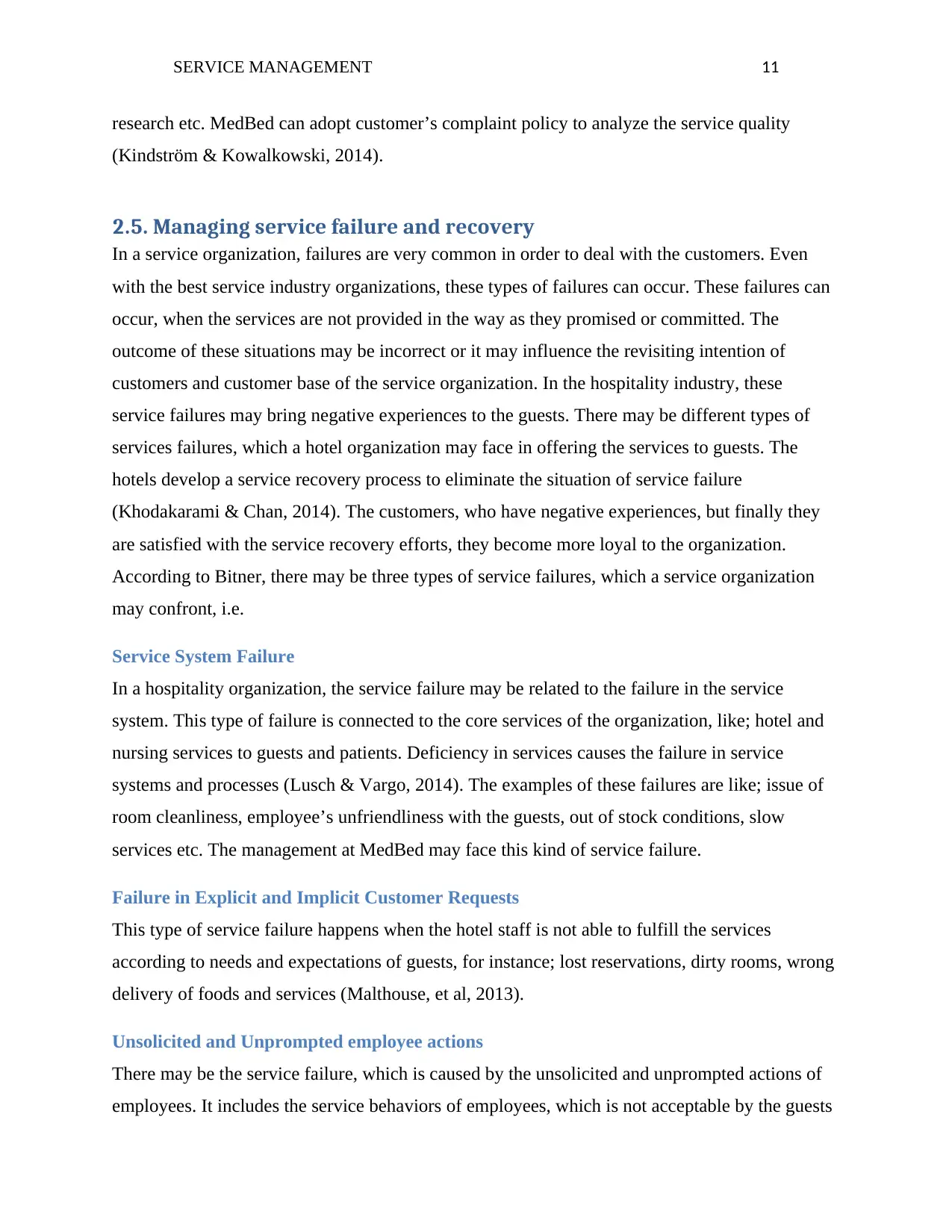
SERVICE MANAGEMENT 11
research etc. MedBed can adopt customer’s complaint policy to analyze the service quality
(Kindström & Kowalkowski, 2014).
2.5. Managing service failure and recovery
In a service organization, failures are very common in order to deal with the customers. Even
with the best service industry organizations, these types of failures can occur. These failures can
occur, when the services are not provided in the way as they promised or committed. The
outcome of these situations may be incorrect or it may influence the revisiting intention of
customers and customer base of the service organization. In the hospitality industry, these
service failures may bring negative experiences to the guests. There may be different types of
services failures, which a hotel organization may face in offering the services to guests. The
hotels develop a service recovery process to eliminate the situation of service failure
(Khodakarami & Chan, 2014). The customers, who have negative experiences, but finally they
are satisfied with the service recovery efforts, they become more loyal to the organization.
According to Bitner, there may be three types of service failures, which a service organization
may confront, i.e.
Service System Failure
In a hospitality organization, the service failure may be related to the failure in the service
system. This type of failure is connected to the core services of the organization, like; hotel and
nursing services to guests and patients. Deficiency in services causes the failure in service
systems and processes (Lusch & Vargo, 2014). The examples of these failures are like; issue of
room cleanliness, employee’s unfriendliness with the guests, out of stock conditions, slow
services etc. The management at MedBed may face this kind of service failure.
Failure in Explicit and Implicit Customer Requests
This type of service failure happens when the hotel staff is not able to fulfill the services
according to needs and expectations of guests, for instance; lost reservations, dirty rooms, wrong
delivery of foods and services (Malthouse, et al, 2013).
Unsolicited and Unprompted employee actions
There may be the service failure, which is caused by the unsolicited and unprompted actions of
employees. It includes the service behaviors of employees, which is not acceptable by the guests
research etc. MedBed can adopt customer’s complaint policy to analyze the service quality
(Kindström & Kowalkowski, 2014).
2.5. Managing service failure and recovery
In a service organization, failures are very common in order to deal with the customers. Even
with the best service industry organizations, these types of failures can occur. These failures can
occur, when the services are not provided in the way as they promised or committed. The
outcome of these situations may be incorrect or it may influence the revisiting intention of
customers and customer base of the service organization. In the hospitality industry, these
service failures may bring negative experiences to the guests. There may be different types of
services failures, which a hotel organization may face in offering the services to guests. The
hotels develop a service recovery process to eliminate the situation of service failure
(Khodakarami & Chan, 2014). The customers, who have negative experiences, but finally they
are satisfied with the service recovery efforts, they become more loyal to the organization.
According to Bitner, there may be three types of service failures, which a service organization
may confront, i.e.
Service System Failure
In a hospitality organization, the service failure may be related to the failure in the service
system. This type of failure is connected to the core services of the organization, like; hotel and
nursing services to guests and patients. Deficiency in services causes the failure in service
systems and processes (Lusch & Vargo, 2014). The examples of these failures are like; issue of
room cleanliness, employee’s unfriendliness with the guests, out of stock conditions, slow
services etc. The management at MedBed may face this kind of service failure.
Failure in Explicit and Implicit Customer Requests
This type of service failure happens when the hotel staff is not able to fulfill the services
according to needs and expectations of guests, for instance; lost reservations, dirty rooms, wrong
delivery of foods and services (Malthouse, et al, 2013).
Unsolicited and Unprompted employee actions
There may be the service failure, which is caused by the unsolicited and unprompted actions of
employees. It includes the service behaviors of employees, which is not acceptable by the guests
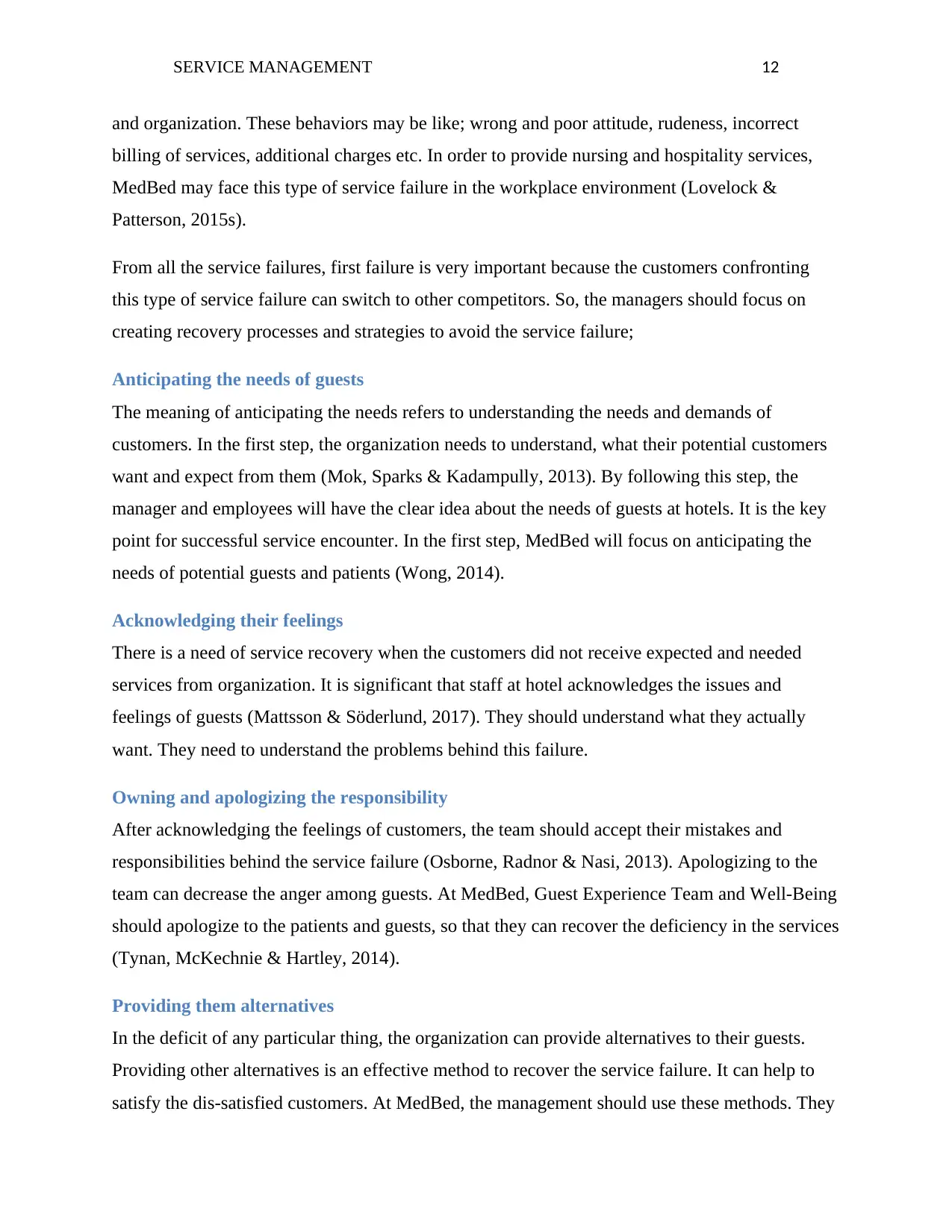
SERVICE MANAGEMENT 12
and organization. These behaviors may be like; wrong and poor attitude, rudeness, incorrect
billing of services, additional charges etc. In order to provide nursing and hospitality services,
MedBed may face this type of service failure in the workplace environment (Lovelock &
Patterson, 2015s).
From all the service failures, first failure is very important because the customers confronting
this type of service failure can switch to other competitors. So, the managers should focus on
creating recovery processes and strategies to avoid the service failure;
Anticipating the needs of guests
The meaning of anticipating the needs refers to understanding the needs and demands of
customers. In the first step, the organization needs to understand, what their potential customers
want and expect from them (Mok, Sparks & Kadampully, 2013). By following this step, the
manager and employees will have the clear idea about the needs of guests at hotels. It is the key
point for successful service encounter. In the first step, MedBed will focus on anticipating the
needs of potential guests and patients (Wong, 2014).
Acknowledging their feelings
There is a need of service recovery when the customers did not receive expected and needed
services from organization. It is significant that staff at hotel acknowledges the issues and
feelings of guests (Mattsson & Söderlund, 2017). They should understand what they actually
want. They need to understand the problems behind this failure.
Owning and apologizing the responsibility
After acknowledging the feelings of customers, the team should accept their mistakes and
responsibilities behind the service failure (Osborne, Radnor & Nasi, 2013). Apologizing to the
team can decrease the anger among guests. At MedBed, Guest Experience Team and Well-Being
should apologize to the patients and guests, so that they can recover the deficiency in the services
(Tynan, McKechnie & Hartley, 2014).
Providing them alternatives
In the deficit of any particular thing, the organization can provide alternatives to their guests.
Providing other alternatives is an effective method to recover the service failure. It can help to
satisfy the dis-satisfied customers. At MedBed, the management should use these methods. They
and organization. These behaviors may be like; wrong and poor attitude, rudeness, incorrect
billing of services, additional charges etc. In order to provide nursing and hospitality services,
MedBed may face this type of service failure in the workplace environment (Lovelock &
Patterson, 2015s).
From all the service failures, first failure is very important because the customers confronting
this type of service failure can switch to other competitors. So, the managers should focus on
creating recovery processes and strategies to avoid the service failure;
Anticipating the needs of guests
The meaning of anticipating the needs refers to understanding the needs and demands of
customers. In the first step, the organization needs to understand, what their potential customers
want and expect from them (Mok, Sparks & Kadampully, 2013). By following this step, the
manager and employees will have the clear idea about the needs of guests at hotels. It is the key
point for successful service encounter. In the first step, MedBed will focus on anticipating the
needs of potential guests and patients (Wong, 2014).
Acknowledging their feelings
There is a need of service recovery when the customers did not receive expected and needed
services from organization. It is significant that staff at hotel acknowledges the issues and
feelings of guests (Mattsson & Söderlund, 2017). They should understand what they actually
want. They need to understand the problems behind this failure.
Owning and apologizing the responsibility
After acknowledging the feelings of customers, the team should accept their mistakes and
responsibilities behind the service failure (Osborne, Radnor & Nasi, 2013). Apologizing to the
team can decrease the anger among guests. At MedBed, Guest Experience Team and Well-Being
should apologize to the patients and guests, so that they can recover the deficiency in the services
(Tynan, McKechnie & Hartley, 2014).
Providing them alternatives
In the deficit of any particular thing, the organization can provide alternatives to their guests.
Providing other alternatives is an effective method to recover the service failure. It can help to
satisfy the dis-satisfied customers. At MedBed, the management should use these methods. They
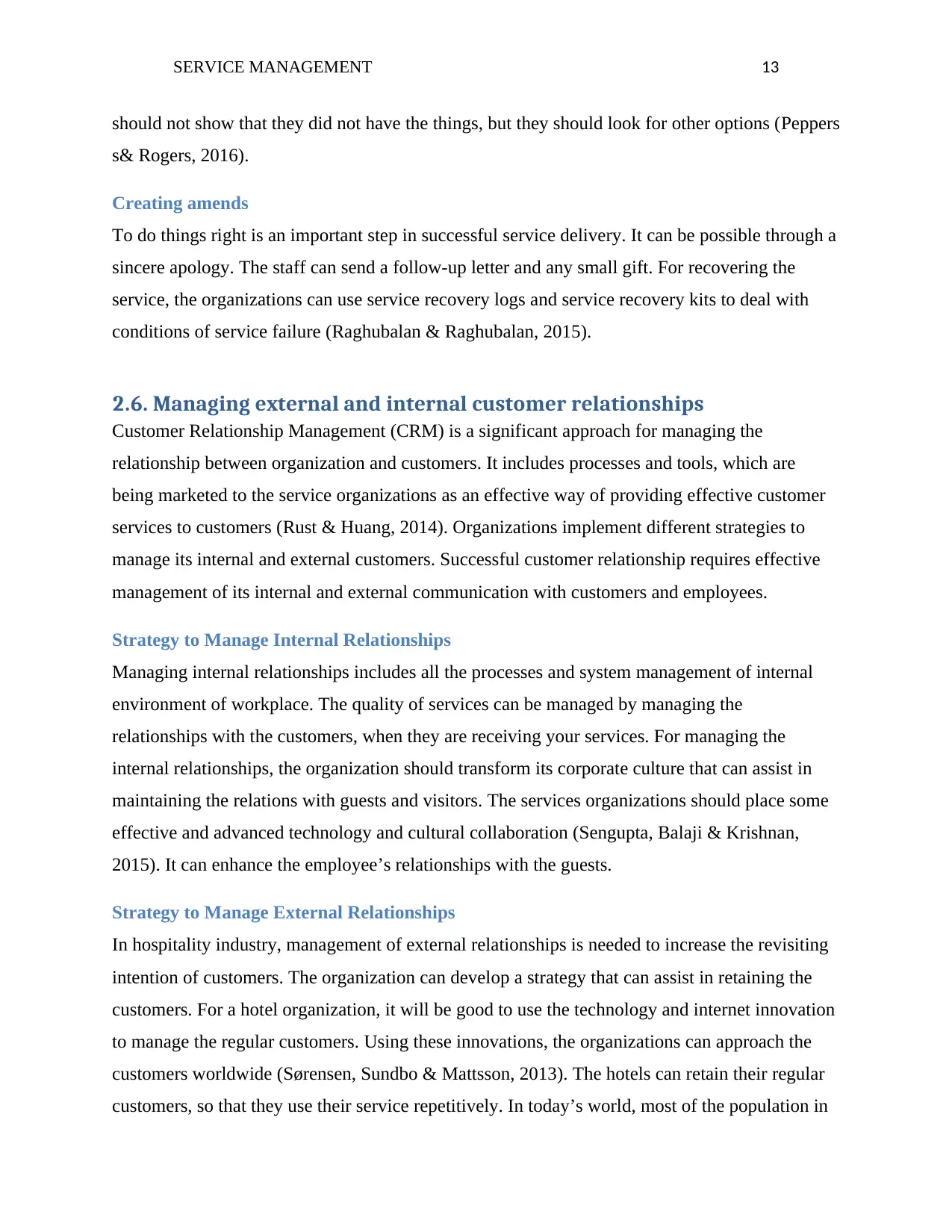
SERVICE MANAGEMENT 13
should not show that they did not have the things, but they should look for other options (Peppers
s& Rogers, 2016).
Creating amends
To do things right is an important step in successful service delivery. It can be possible through a
sincere apology. The staff can send a follow-up letter and any small gift. For recovering the
service, the organizations can use service recovery logs and service recovery kits to deal with
conditions of service failure (Raghubalan & Raghubalan, 2015).
2.6. Managing external and internal customer relationships
Customer Relationship Management (CRM) is a significant approach for managing the
relationship between organization and customers. It includes processes and tools, which are
being marketed to the service organizations as an effective way of providing effective customer
services to customers (Rust & Huang, 2014). Organizations implement different strategies to
manage its internal and external customers. Successful customer relationship requires effective
management of its internal and external communication with customers and employees.
Strategy to Manage Internal Relationships
Managing internal relationships includes all the processes and system management of internal
environment of workplace. The quality of services can be managed by managing the
relationships with the customers, when they are receiving your services. For managing the
internal relationships, the organization should transform its corporate culture that can assist in
maintaining the relations with guests and visitors. The services organizations should place some
effective and advanced technology and cultural collaboration (Sengupta, Balaji & Krishnan,
2015). It can enhance the employee’s relationships with the guests.
Strategy to Manage External Relationships
In hospitality industry, management of external relationships is needed to increase the revisiting
intention of customers. The organization can develop a strategy that can assist in retaining the
customers. For a hotel organization, it will be good to use the technology and internet innovation
to manage the regular customers. Using these innovations, the organizations can approach the
customers worldwide (Sørensen, Sundbo & Mattsson, 2013). The hotels can retain their regular
customers, so that they use their service repetitively. In today’s world, most of the population in
should not show that they did not have the things, but they should look for other options (Peppers
s& Rogers, 2016).
Creating amends
To do things right is an important step in successful service delivery. It can be possible through a
sincere apology. The staff can send a follow-up letter and any small gift. For recovering the
service, the organizations can use service recovery logs and service recovery kits to deal with
conditions of service failure (Raghubalan & Raghubalan, 2015).
2.6. Managing external and internal customer relationships
Customer Relationship Management (CRM) is a significant approach for managing the
relationship between organization and customers. It includes processes and tools, which are
being marketed to the service organizations as an effective way of providing effective customer
services to customers (Rust & Huang, 2014). Organizations implement different strategies to
manage its internal and external customers. Successful customer relationship requires effective
management of its internal and external communication with customers and employees.
Strategy to Manage Internal Relationships
Managing internal relationships includes all the processes and system management of internal
environment of workplace. The quality of services can be managed by managing the
relationships with the customers, when they are receiving your services. For managing the
internal relationships, the organization should transform its corporate culture that can assist in
maintaining the relations with guests and visitors. The services organizations should place some
effective and advanced technology and cultural collaboration (Sengupta, Balaji & Krishnan,
2015). It can enhance the employee’s relationships with the guests.
Strategy to Manage External Relationships
In hospitality industry, management of external relationships is needed to increase the revisiting
intention of customers. The organization can develop a strategy that can assist in retaining the
customers. For a hotel organization, it will be good to use the technology and internet innovation
to manage the regular customers. Using these innovations, the organizations can approach the
customers worldwide (Sørensen, Sundbo & Mattsson, 2013). The hotels can retain their regular
customers, so that they use their service repetitively. In today’s world, most of the population in
Paraphrase This Document
Need a fresh take? Get an instant paraphrase of this document with our AI Paraphraser
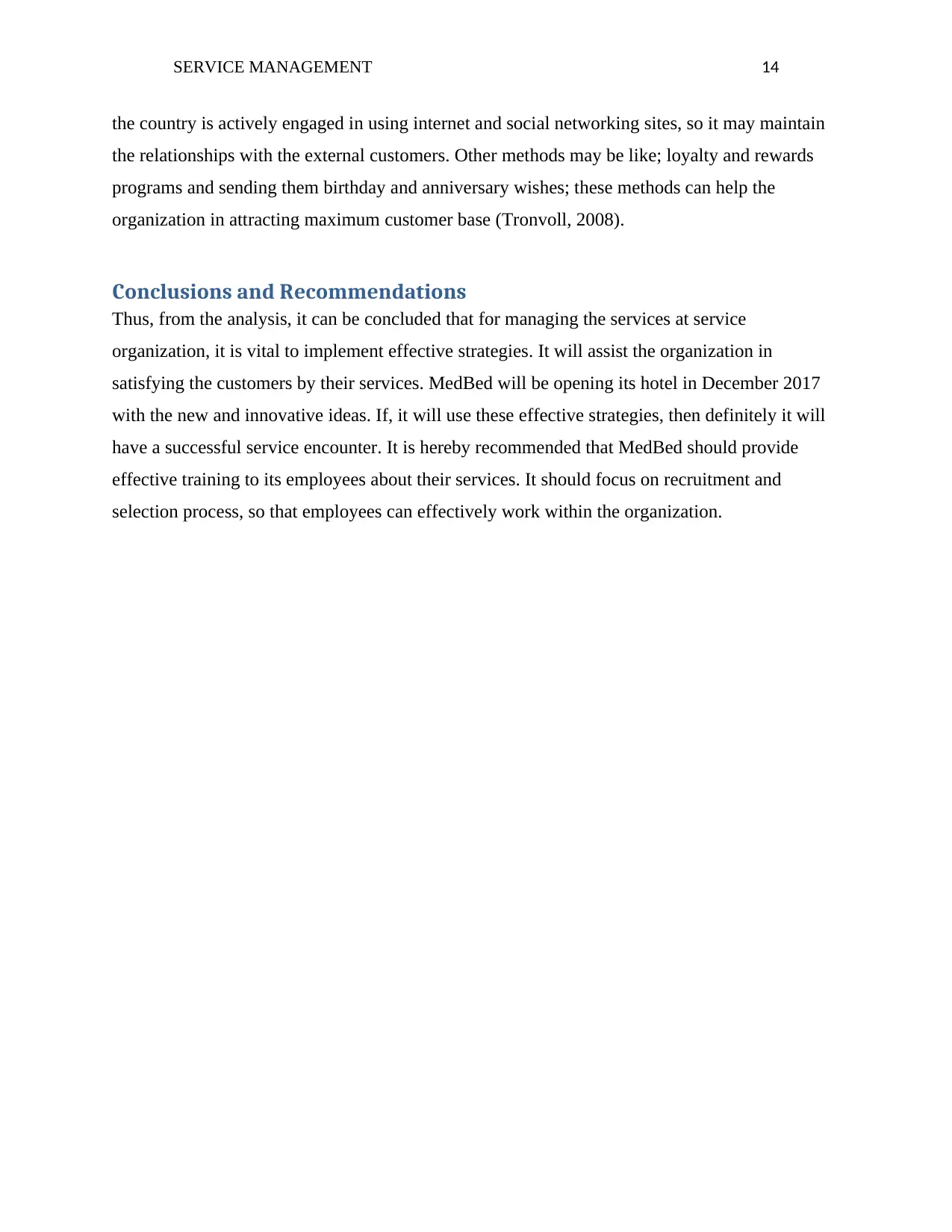
SERVICE MANAGEMENT 14
the country is actively engaged in using internet and social networking sites, so it may maintain
the relationships with the external customers. Other methods may be like; loyalty and rewards
programs and sending them birthday and anniversary wishes; these methods can help the
organization in attracting maximum customer base (Tronvoll, 2008).
Conclusions and Recommendations
Thus, from the analysis, it can be concluded that for managing the services at service
organization, it is vital to implement effective strategies. It will assist the organization in
satisfying the customers by their services. MedBed will be opening its hotel in December 2017
with the new and innovative ideas. If, it will use these effective strategies, then definitely it will
have a successful service encounter. It is hereby recommended that MedBed should provide
effective training to its employees about their services. It should focus on recruitment and
selection process, so that employees can effectively work within the organization.
the country is actively engaged in using internet and social networking sites, so it may maintain
the relationships with the external customers. Other methods may be like; loyalty and rewards
programs and sending them birthday and anniversary wishes; these methods can help the
organization in attracting maximum customer base (Tronvoll, 2008).
Conclusions and Recommendations
Thus, from the analysis, it can be concluded that for managing the services at service
organization, it is vital to implement effective strategies. It will assist the organization in
satisfying the customers by their services. MedBed will be opening its hotel in December 2017
with the new and innovative ideas. If, it will use these effective strategies, then definitely it will
have a successful service encounter. It is hereby recommended that MedBed should provide
effective training to its employees about their services. It should focus on recruitment and
selection process, so that employees can effectively work within the organization.
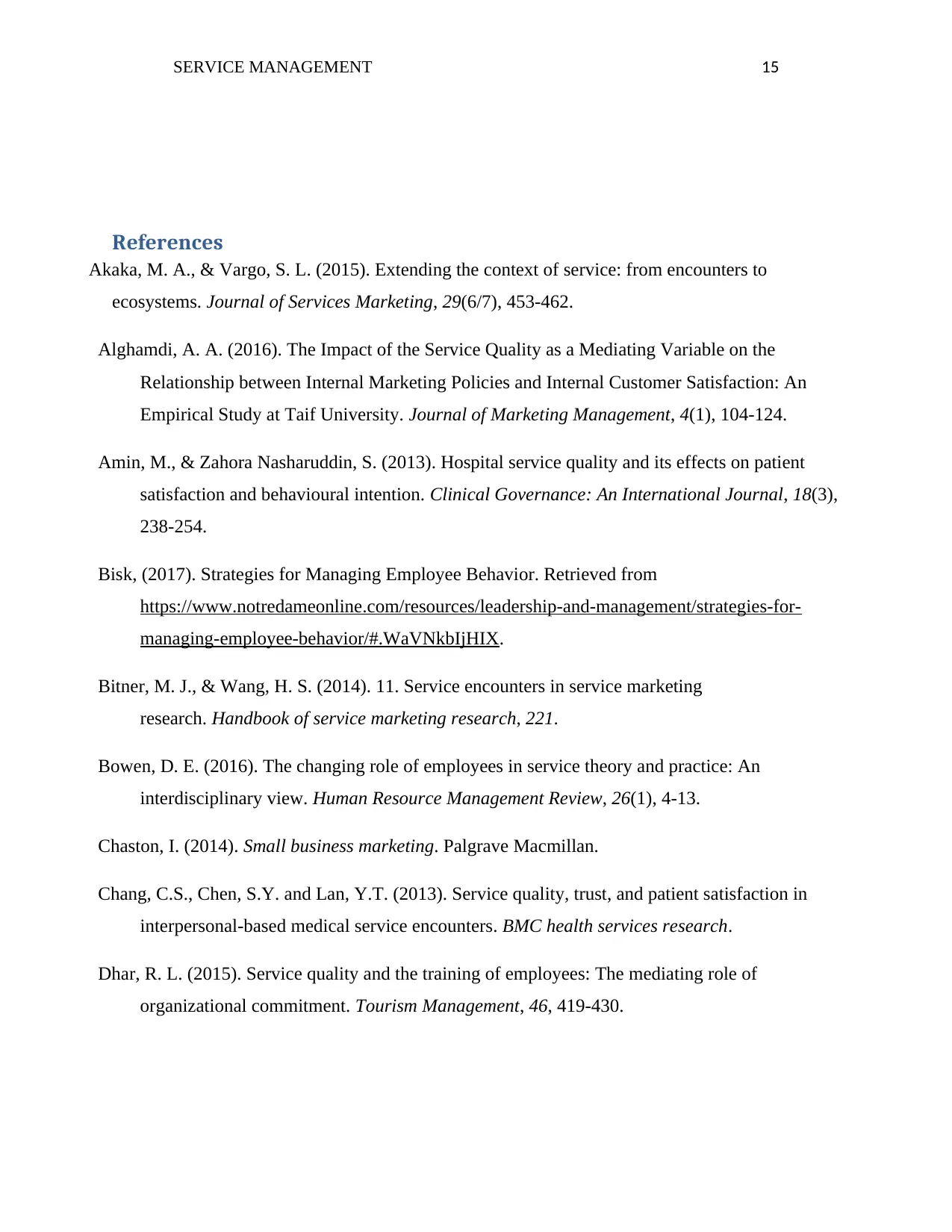
SERVICE MANAGEMENT 15
References
Akaka, M. A., & Vargo, S. L. (2015). Extending the context of service: from encounters to
ecosystems. Journal of Services Marketing, 29(6/7), 453-462.
Alghamdi, A. A. (2016). The Impact of the Service Quality as a Mediating Variable on the
Relationship between Internal Marketing Policies and Internal Customer Satisfaction: An
Empirical Study at Taif University. Journal of Marketing Management, 4(1), 104-124.
Amin, M., & Zahora Nasharuddin, S. (2013). Hospital service quality and its effects on patient
satisfaction and behavioural intention. Clinical Governance: An International Journal, 18(3),
238-254.
Bisk, (2017). Strategies for Managing Employee Behavior. Retrieved from
https://www.notredameonline.com/resources/leadership-and-management/strategies-for-
managing-employee-behavior/#.WaVNkbIjHIX.
Bitner, M. J., & Wang, H. S. (2014). 11. Service encounters in service marketing
research. Handbook of service marketing research, 221.
Bowen, D. E. (2016). The changing role of employees in service theory and practice: An
interdisciplinary view. Human Resource Management Review, 26(1), 4-13.
Chaston, I. (2014). Small business marketing. Palgrave Macmillan.
Chang, C.S., Chen, S.Y. and Lan, Y.T. (2013). Service quality, trust, and patient satisfaction in
interpersonal-based medical service encounters. BMC health services research.
Dhar, R. L. (2015). Service quality and the training of employees: The mediating role of
organizational commitment. Tourism Management, 46, 419-430.
References
Akaka, M. A., & Vargo, S. L. (2015). Extending the context of service: from encounters to
ecosystems. Journal of Services Marketing, 29(6/7), 453-462.
Alghamdi, A. A. (2016). The Impact of the Service Quality as a Mediating Variable on the
Relationship between Internal Marketing Policies and Internal Customer Satisfaction: An
Empirical Study at Taif University. Journal of Marketing Management, 4(1), 104-124.
Amin, M., & Zahora Nasharuddin, S. (2013). Hospital service quality and its effects on patient
satisfaction and behavioural intention. Clinical Governance: An International Journal, 18(3),
238-254.
Bisk, (2017). Strategies for Managing Employee Behavior. Retrieved from
https://www.notredameonline.com/resources/leadership-and-management/strategies-for-
managing-employee-behavior/#.WaVNkbIjHIX.
Bitner, M. J., & Wang, H. S. (2014). 11. Service encounters in service marketing
research. Handbook of service marketing research, 221.
Bowen, D. E. (2016). The changing role of employees in service theory and practice: An
interdisciplinary view. Human Resource Management Review, 26(1), 4-13.
Chaston, I. (2014). Small business marketing. Palgrave Macmillan.
Chang, C.S., Chen, S.Y. and Lan, Y.T. (2013). Service quality, trust, and patient satisfaction in
interpersonal-based medical service encounters. BMC health services research.
Dhar, R. L. (2015). Service quality and the training of employees: The mediating role of
organizational commitment. Tourism Management, 46, 419-430.
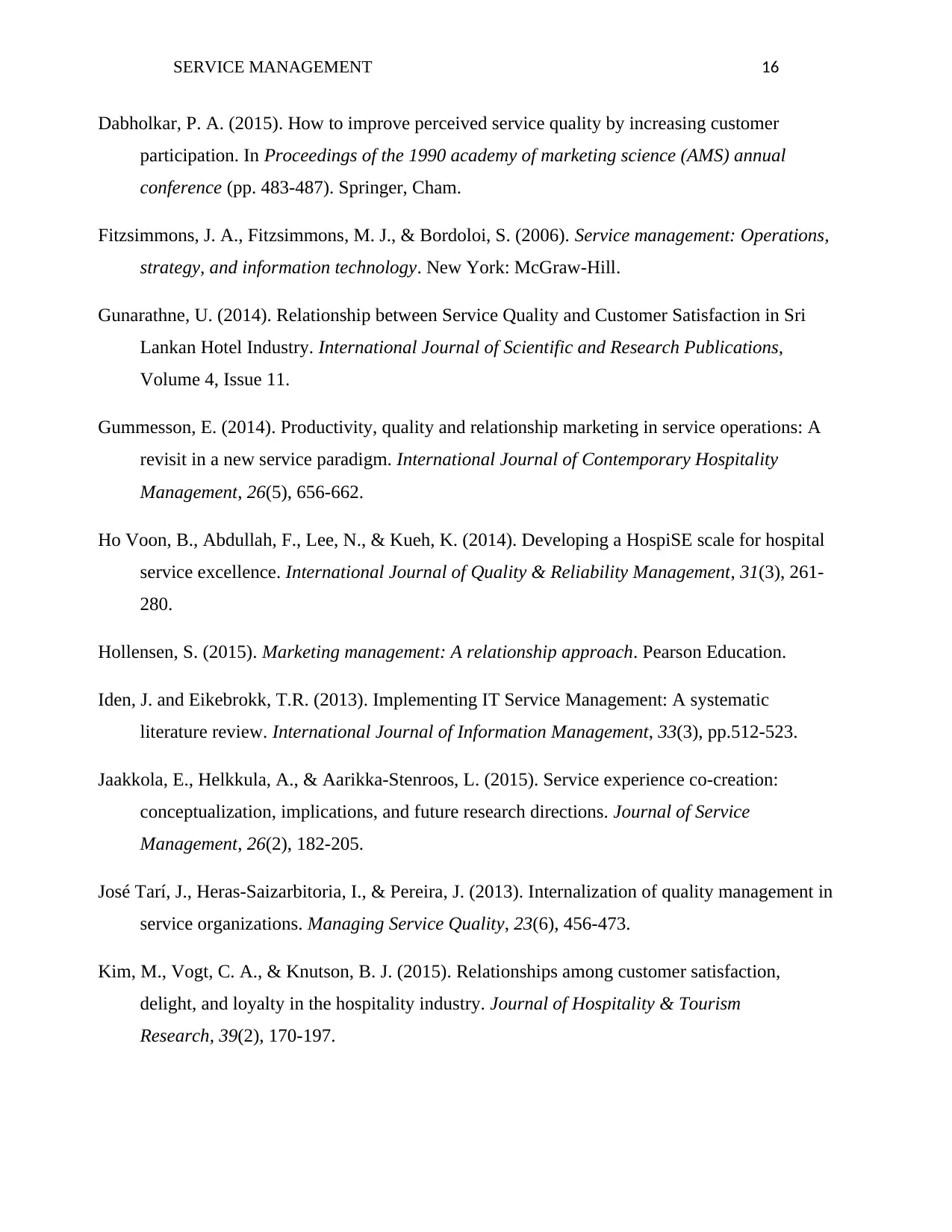
SERVICE MANAGEMENT 16
Dabholkar, P. A. (2015). How to improve perceived service quality by increasing customer
participation. In Proceedings of the 1990 academy of marketing science (AMS) annual
conference (pp. 483-487). Springer, Cham.
Fitzsimmons, J. A., Fitzsimmons, M. J., & Bordoloi, S. (2006). Service management: Operations,
strategy, and information technology. New York: McGraw-Hill.
Gunarathne, U. (2014). Relationship between Service Quality and Customer Satisfaction in Sri
Lankan Hotel Industry. International Journal of Scientific and Research Publications,
Volume 4, Issue 11.
Gummesson, E. (2014). Productivity, quality and relationship marketing in service operations: A
revisit in a new service paradigm. International Journal of Contemporary Hospitality
Management, 26(5), 656-662.
Ho Voon, B., Abdullah, F., Lee, N., & Kueh, K. (2014). Developing a HospiSE scale for hospital
service excellence. International Journal of Quality & Reliability Management, 31(3), 261-
280.
Hollensen, S. (2015). Marketing management: A relationship approach. Pearson Education.
Iden, J. and Eikebrokk, T.R. (2013). Implementing IT Service Management: A systematic
literature review. International Journal of Information Management, 33(3), pp.512-523.
Jaakkola, E., Helkkula, A., & Aarikka-Stenroos, L. (2015). Service experience co-creation:
conceptualization, implications, and future research directions. Journal of Service
Management, 26(2), 182-205.
José Tarí, J., Heras-Saizarbitoria, I., & Pereira, J. (2013). Internalization of quality management in
service organizations. Managing Service Quality, 23(6), 456-473.
Kim, M., Vogt, C. A., & Knutson, B. J. (2015). Relationships among customer satisfaction,
delight, and loyalty in the hospitality industry. Journal of Hospitality & Tourism
Research, 39(2), 170-197.
Dabholkar, P. A. (2015). How to improve perceived service quality by increasing customer
participation. In Proceedings of the 1990 academy of marketing science (AMS) annual
conference (pp. 483-487). Springer, Cham.
Fitzsimmons, J. A., Fitzsimmons, M. J., & Bordoloi, S. (2006). Service management: Operations,
strategy, and information technology. New York: McGraw-Hill.
Gunarathne, U. (2014). Relationship between Service Quality and Customer Satisfaction in Sri
Lankan Hotel Industry. International Journal of Scientific and Research Publications,
Volume 4, Issue 11.
Gummesson, E. (2014). Productivity, quality and relationship marketing in service operations: A
revisit in a new service paradigm. International Journal of Contemporary Hospitality
Management, 26(5), 656-662.
Ho Voon, B., Abdullah, F., Lee, N., & Kueh, K. (2014). Developing a HospiSE scale for hospital
service excellence. International Journal of Quality & Reliability Management, 31(3), 261-
280.
Hollensen, S. (2015). Marketing management: A relationship approach. Pearson Education.
Iden, J. and Eikebrokk, T.R. (2013). Implementing IT Service Management: A systematic
literature review. International Journal of Information Management, 33(3), pp.512-523.
Jaakkola, E., Helkkula, A., & Aarikka-Stenroos, L. (2015). Service experience co-creation:
conceptualization, implications, and future research directions. Journal of Service
Management, 26(2), 182-205.
José Tarí, J., Heras-Saizarbitoria, I., & Pereira, J. (2013). Internalization of quality management in
service organizations. Managing Service Quality, 23(6), 456-473.
Kim, M., Vogt, C. A., & Knutson, B. J. (2015). Relationships among customer satisfaction,
delight, and loyalty in the hospitality industry. Journal of Hospitality & Tourism
Research, 39(2), 170-197.
Secure Best Marks with AI Grader
Need help grading? Try our AI Grader for instant feedback on your assignments.
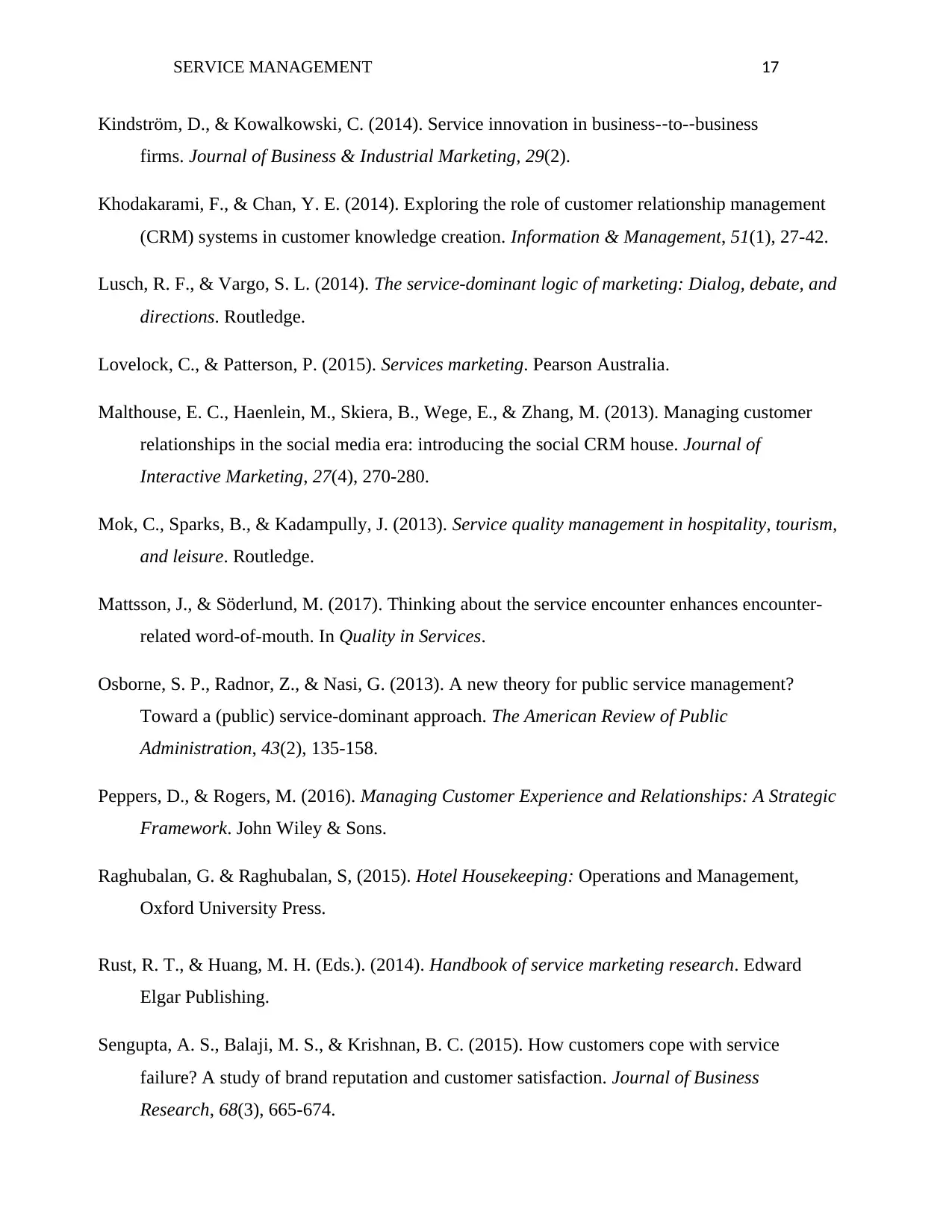
SERVICE MANAGEMENT 17
Kindström, D., & Kowalkowski, C. (2014). Service innovation in business-‐to-‐business
firms. Journal of Business & Industrial Marketing, 29(2).
Khodakarami, F., & Chan, Y. E. (2014). Exploring the role of customer relationship management
(CRM) systems in customer knowledge creation. Information & Management, 51(1), 27-42.
Lusch, R. F., & Vargo, S. L. (2014). The service-dominant logic of marketing: Dialog, debate, and
directions. Routledge.
Lovelock, C., & Patterson, P. (2015). Services marketing. Pearson Australia.
Malthouse, E. C., Haenlein, M., Skiera, B., Wege, E., & Zhang, M. (2013). Managing customer
relationships in the social media era: introducing the social CRM house. Journal of
Interactive Marketing, 27(4), 270-280.
Mok, C., Sparks, B., & Kadampully, J. (2013). Service quality management in hospitality, tourism,
and leisure. Routledge.
Mattsson, J., & Söderlund, M. (2017). Thinking about the service encounter enhances encounter-
related word-of-mouth. In Quality in Services.
Osborne, S. P., Radnor, Z., & Nasi, G. (2013). A new theory for public service management?
Toward a (public) service-dominant approach. The American Review of Public
Administration, 43(2), 135-158.
Peppers, D., & Rogers, M. (2016). Managing Customer Experience and Relationships: A Strategic
Framework. John Wiley & Sons.
Raghubalan, G. & Raghubalan, S, (2015). Hotel Housekeeping: Operations and Management,
Oxford University Press.
Rust, R. T., & Huang, M. H. (Eds.). (2014). Handbook of service marketing research. Edward
Elgar Publishing.
Sengupta, A. S., Balaji, M. S., & Krishnan, B. C. (2015). How customers cope with service
failure? A study of brand reputation and customer satisfaction. Journal of Business
Research, 68(3), 665-674.
Kindström, D., & Kowalkowski, C. (2014). Service innovation in business-‐to-‐business
firms. Journal of Business & Industrial Marketing, 29(2).
Khodakarami, F., & Chan, Y. E. (2014). Exploring the role of customer relationship management
(CRM) systems in customer knowledge creation. Information & Management, 51(1), 27-42.
Lusch, R. F., & Vargo, S. L. (2014). The service-dominant logic of marketing: Dialog, debate, and
directions. Routledge.
Lovelock, C., & Patterson, P. (2015). Services marketing. Pearson Australia.
Malthouse, E. C., Haenlein, M., Skiera, B., Wege, E., & Zhang, M. (2013). Managing customer
relationships in the social media era: introducing the social CRM house. Journal of
Interactive Marketing, 27(4), 270-280.
Mok, C., Sparks, B., & Kadampully, J. (2013). Service quality management in hospitality, tourism,
and leisure. Routledge.
Mattsson, J., & Söderlund, M. (2017). Thinking about the service encounter enhances encounter-
related word-of-mouth. In Quality in Services.
Osborne, S. P., Radnor, Z., & Nasi, G. (2013). A new theory for public service management?
Toward a (public) service-dominant approach. The American Review of Public
Administration, 43(2), 135-158.
Peppers, D., & Rogers, M. (2016). Managing Customer Experience and Relationships: A Strategic
Framework. John Wiley & Sons.
Raghubalan, G. & Raghubalan, S, (2015). Hotel Housekeeping: Operations and Management,
Oxford University Press.
Rust, R. T., & Huang, M. H. (Eds.). (2014). Handbook of service marketing research. Edward
Elgar Publishing.
Sengupta, A. S., Balaji, M. S., & Krishnan, B. C. (2015). How customers cope with service
failure? A study of brand reputation and customer satisfaction. Journal of Business
Research, 68(3), 665-674.
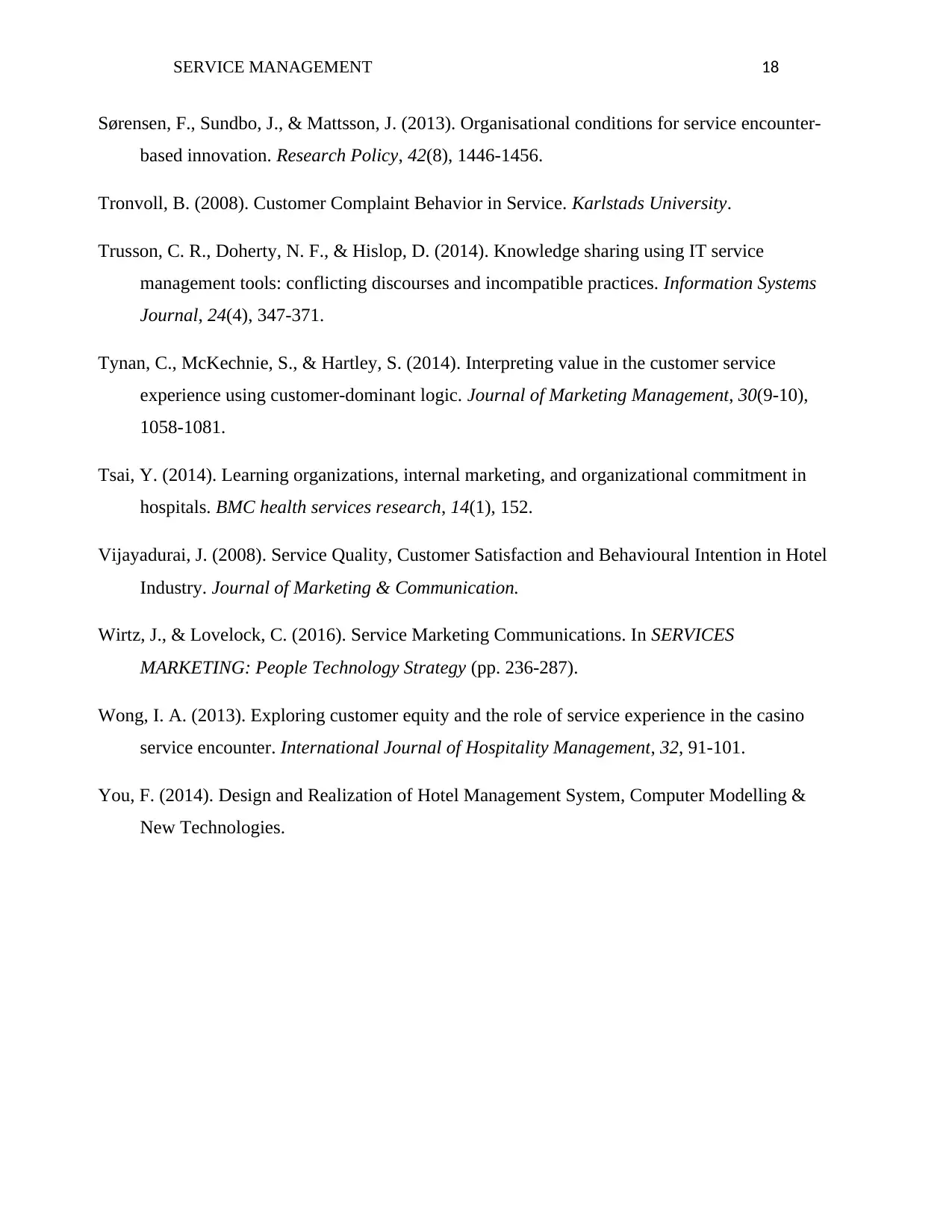
SERVICE MANAGEMENT 18
Sørensen, F., Sundbo, J., & Mattsson, J. (2013). Organisational conditions for service encounter-
based innovation. Research Policy, 42(8), 1446-1456.
Tronvoll, B. (2008). Customer Complaint Behavior in Service. Karlstads University.
Trusson, C. R., Doherty, N. F., & Hislop, D. (2014). Knowledge sharing using IT service
management tools: conflicting discourses and incompatible practices. Information Systems
Journal, 24(4), 347-371.
Tynan, C., McKechnie, S., & Hartley, S. (2014). Interpreting value in the customer service
experience using customer-dominant logic. Journal of Marketing Management, 30(9-10),
1058-1081.
Tsai, Y. (2014). Learning organizations, internal marketing, and organizational commitment in
hospitals. BMC health services research, 14(1), 152.
Vijayadurai, J. (2008). Service Quality, Customer Satisfaction and Behavioural Intention in Hotel
Industry. Journal of Marketing & Communication.
Wirtz, J., & Lovelock, C. (2016). Service Marketing Communications. In SERVICES
MARKETING: People Technology Strategy (pp. 236-287).
Wong, I. A. (2013). Exploring customer equity and the role of service experience in the casino
service encounter. International Journal of Hospitality Management, 32, 91-101.
You, F. (2014). Design and Realization of Hotel Management System, Computer Modelling &
New Technologies.
Sørensen, F., Sundbo, J., & Mattsson, J. (2013). Organisational conditions for service encounter-
based innovation. Research Policy, 42(8), 1446-1456.
Tronvoll, B. (2008). Customer Complaint Behavior in Service. Karlstads University.
Trusson, C. R., Doherty, N. F., & Hislop, D. (2014). Knowledge sharing using IT service
management tools: conflicting discourses and incompatible practices. Information Systems
Journal, 24(4), 347-371.
Tynan, C., McKechnie, S., & Hartley, S. (2014). Interpreting value in the customer service
experience using customer-dominant logic. Journal of Marketing Management, 30(9-10),
1058-1081.
Tsai, Y. (2014). Learning organizations, internal marketing, and organizational commitment in
hospitals. BMC health services research, 14(1), 152.
Vijayadurai, J. (2008). Service Quality, Customer Satisfaction and Behavioural Intention in Hotel
Industry. Journal of Marketing & Communication.
Wirtz, J., & Lovelock, C. (2016). Service Marketing Communications. In SERVICES
MARKETING: People Technology Strategy (pp. 236-287).
Wong, I. A. (2013). Exploring customer equity and the role of service experience in the casino
service encounter. International Journal of Hospitality Management, 32, 91-101.
You, F. (2014). Design and Realization of Hotel Management System, Computer Modelling &
New Technologies.
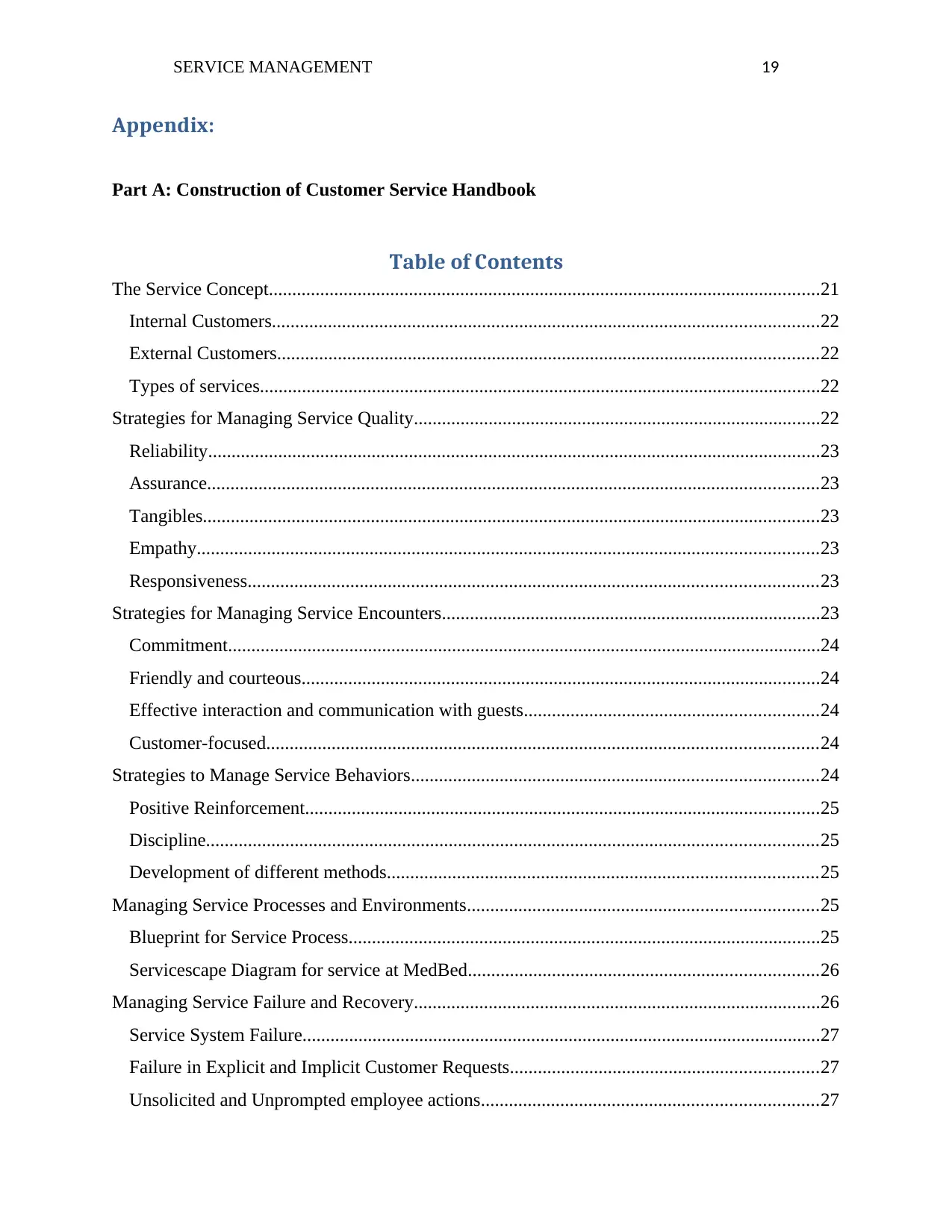
SERVICE MANAGEMENT 19
Appendix:
Part A: Construction of Customer Service Handbook
Table of Contents
The Service Concept......................................................................................................................21
Internal Customers.....................................................................................................................22
External Customers....................................................................................................................22
Types of services........................................................................................................................22
Strategies for Managing Service Quality.......................................................................................22
Reliability...................................................................................................................................23
Assurance...................................................................................................................................23
Tangibles....................................................................................................................................23
Empathy.....................................................................................................................................23
Responsiveness..........................................................................................................................23
Strategies for Managing Service Encounters.................................................................................23
Commitment...............................................................................................................................24
Friendly and courteous...............................................................................................................24
Effective interaction and communication with guests...............................................................24
Customer-focused......................................................................................................................24
Strategies to Manage Service Behaviors.......................................................................................24
Positive Reinforcement..............................................................................................................25
Discipline...................................................................................................................................25
Development of different methods............................................................................................25
Managing Service Processes and Environments...........................................................................25
Blueprint for Service Process.....................................................................................................25
Servicescape Diagram for service at MedBed...........................................................................26
Managing Service Failure and Recovery.......................................................................................26
Service System Failure...............................................................................................................27
Failure in Explicit and Implicit Customer Requests..................................................................27
Unsolicited and Unprompted employee actions........................................................................27
Appendix:
Part A: Construction of Customer Service Handbook
Table of Contents
The Service Concept......................................................................................................................21
Internal Customers.....................................................................................................................22
External Customers....................................................................................................................22
Types of services........................................................................................................................22
Strategies for Managing Service Quality.......................................................................................22
Reliability...................................................................................................................................23
Assurance...................................................................................................................................23
Tangibles....................................................................................................................................23
Empathy.....................................................................................................................................23
Responsiveness..........................................................................................................................23
Strategies for Managing Service Encounters.................................................................................23
Commitment...............................................................................................................................24
Friendly and courteous...............................................................................................................24
Effective interaction and communication with guests...............................................................24
Customer-focused......................................................................................................................24
Strategies to Manage Service Behaviors.......................................................................................24
Positive Reinforcement..............................................................................................................25
Discipline...................................................................................................................................25
Development of different methods............................................................................................25
Managing Service Processes and Environments...........................................................................25
Blueprint for Service Process.....................................................................................................25
Servicescape Diagram for service at MedBed...........................................................................26
Managing Service Failure and Recovery.......................................................................................26
Service System Failure...............................................................................................................27
Failure in Explicit and Implicit Customer Requests..................................................................27
Unsolicited and Unprompted employee actions........................................................................27
Paraphrase This Document
Need a fresh take? Get an instant paraphrase of this document with our AI Paraphraser
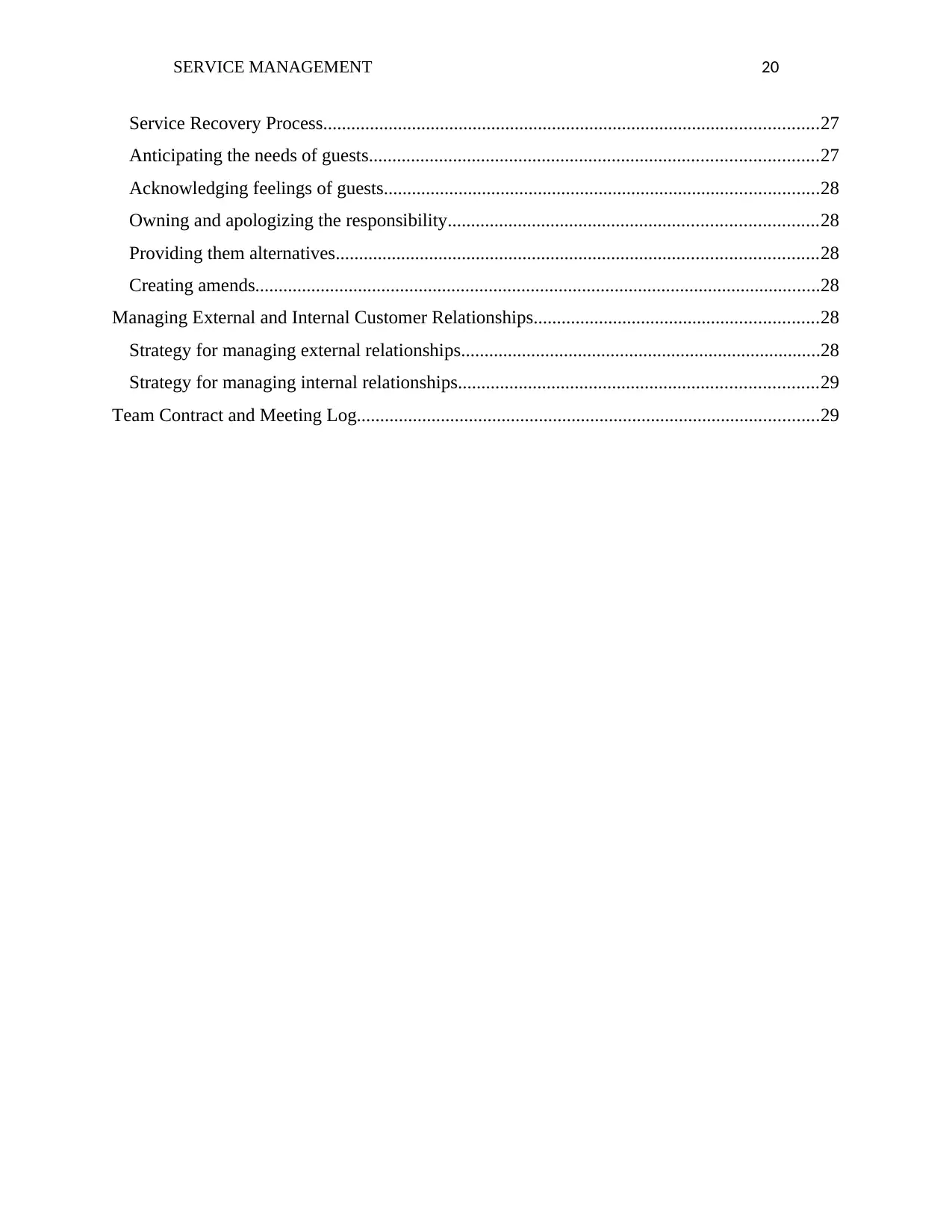
SERVICE MANAGEMENT 20
Service Recovery Process..........................................................................................................27
Anticipating the needs of guests................................................................................................27
Acknowledging feelings of guests.............................................................................................28
Owning and apologizing the responsibility...............................................................................28
Providing them alternatives.......................................................................................................28
Creating amends.........................................................................................................................28
Managing External and Internal Customer Relationships.............................................................28
Strategy for managing external relationships.............................................................................28
Strategy for managing internal relationships.............................................................................29
Team Contract and Meeting Log...................................................................................................29
Service Recovery Process..........................................................................................................27
Anticipating the needs of guests................................................................................................27
Acknowledging feelings of guests.............................................................................................28
Owning and apologizing the responsibility...............................................................................28
Providing them alternatives.......................................................................................................28
Creating amends.........................................................................................................................28
Managing External and Internal Customer Relationships.............................................................28
Strategy for managing external relationships.............................................................................28
Strategy for managing internal relationships.............................................................................29
Team Contract and Meeting Log...................................................................................................29
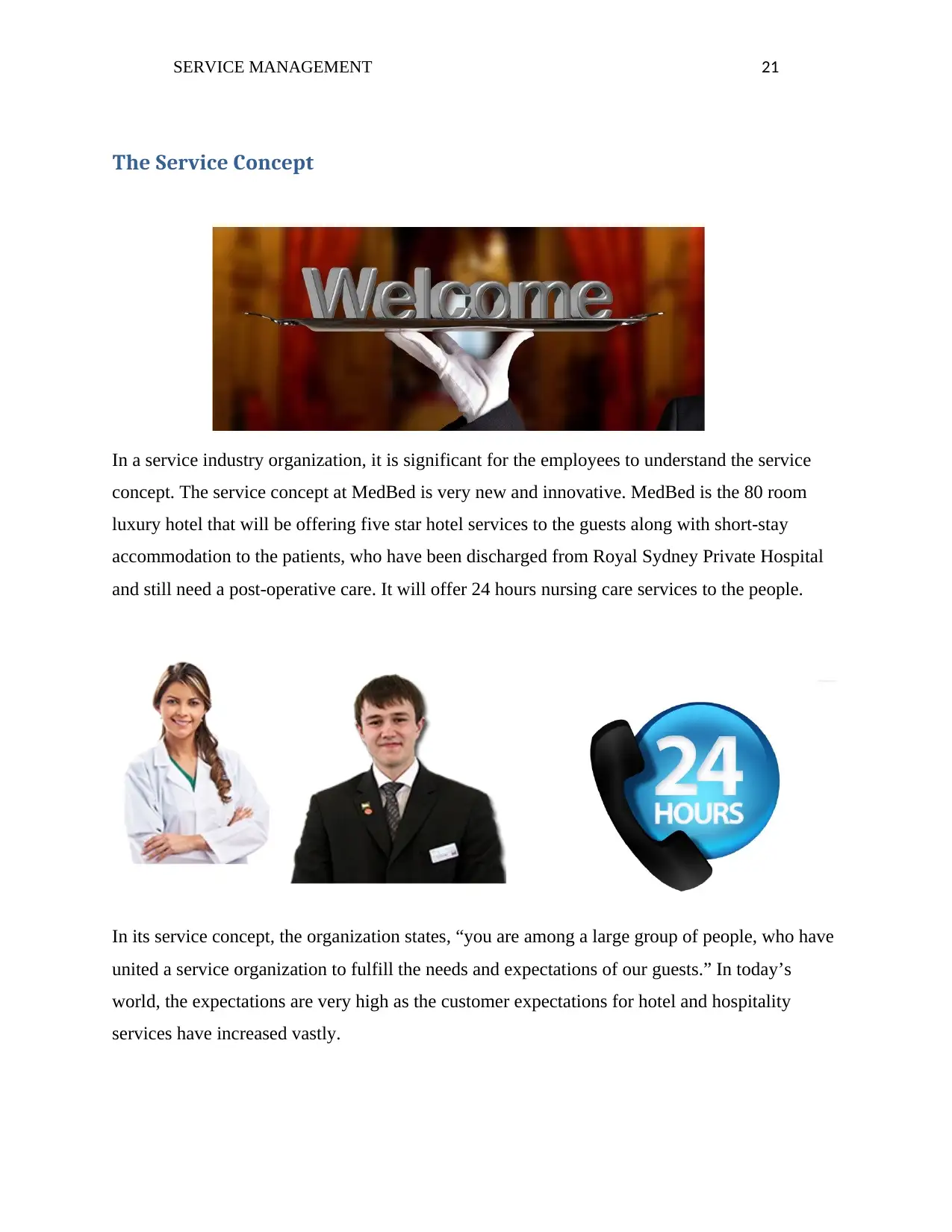
SERVICE MANAGEMENT 21
The Service Concept
In a service industry organization, it is significant for the employees to understand the service
concept. The service concept at MedBed is very new and innovative. MedBed is the 80 room
luxury hotel that will be offering five star hotel services to the guests along with short-stay
accommodation to the patients, who have been discharged from Royal Sydney Private Hospital
and still need a post-operative care. It will offer 24 hours nursing care services to the people.
In its service concept, the organization states, “you are among a large group of people, who have
united a service organization to fulfill the needs and expectations of our guests.” In today’s
world, the expectations are very high as the customer expectations for hotel and hospitality
services have increased vastly.
The Service Concept
In a service industry organization, it is significant for the employees to understand the service
concept. The service concept at MedBed is very new and innovative. MedBed is the 80 room
luxury hotel that will be offering five star hotel services to the guests along with short-stay
accommodation to the patients, who have been discharged from Royal Sydney Private Hospital
and still need a post-operative care. It will offer 24 hours nursing care services to the people.
In its service concept, the organization states, “you are among a large group of people, who have
united a service organization to fulfill the needs and expectations of our guests.” In today’s
world, the expectations are very high as the customer expectations for hotel and hospitality
services have increased vastly.
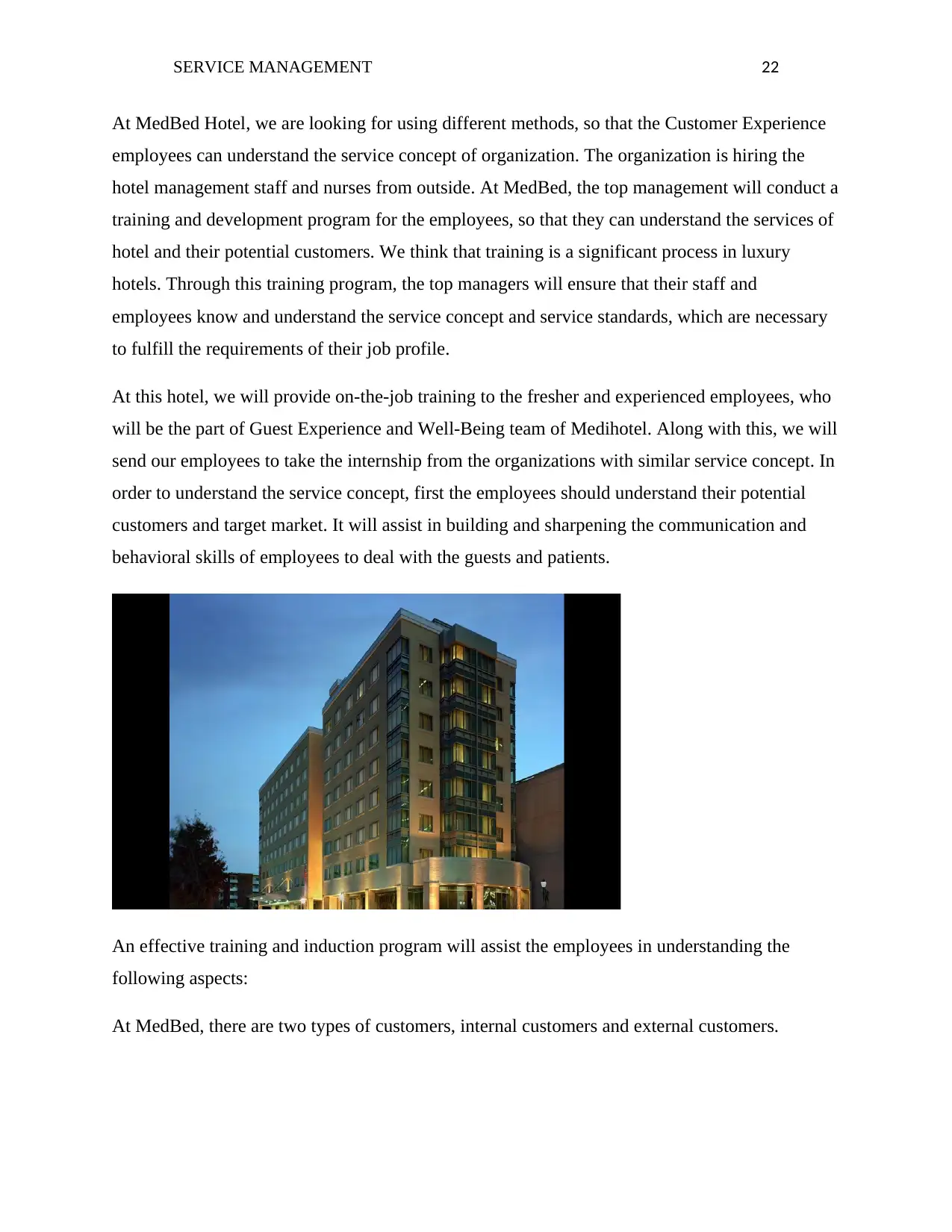
SERVICE MANAGEMENT 22
At MedBed Hotel, we are looking for using different methods, so that the Customer Experience
employees can understand the service concept of organization. The organization is hiring the
hotel management staff and nurses from outside. At MedBed, the top management will conduct a
training and development program for the employees, so that they can understand the services of
hotel and their potential customers. We think that training is a significant process in luxury
hotels. Through this training program, the top managers will ensure that their staff and
employees know and understand the service concept and service standards, which are necessary
to fulfill the requirements of their job profile.
At this hotel, we will provide on-the-job training to the fresher and experienced employees, who
will be the part of Guest Experience and Well-Being team of Medihotel. Along with this, we will
send our employees to take the internship from the organizations with similar service concept. In
order to understand the service concept, first the employees should understand their potential
customers and target market. It will assist in building and sharpening the communication and
behavioral skills of employees to deal with the guests and patients.
An effective training and induction program will assist the employees in understanding the
following aspects:
At MedBed, there are two types of customers, internal customers and external customers.
At MedBed Hotel, we are looking for using different methods, so that the Customer Experience
employees can understand the service concept of organization. The organization is hiring the
hotel management staff and nurses from outside. At MedBed, the top management will conduct a
training and development program for the employees, so that they can understand the services of
hotel and their potential customers. We think that training is a significant process in luxury
hotels. Through this training program, the top managers will ensure that their staff and
employees know and understand the service concept and service standards, which are necessary
to fulfill the requirements of their job profile.
At this hotel, we will provide on-the-job training to the fresher and experienced employees, who
will be the part of Guest Experience and Well-Being team of Medihotel. Along with this, we will
send our employees to take the internship from the organizations with similar service concept. In
order to understand the service concept, first the employees should understand their potential
customers and target market. It will assist in building and sharpening the communication and
behavioral skills of employees to deal with the guests and patients.
An effective training and induction program will assist the employees in understanding the
following aspects:
At MedBed, there are two types of customers, internal customers and external customers.
Secure Best Marks with AI Grader
Need help grading? Try our AI Grader for instant feedback on your assignments.
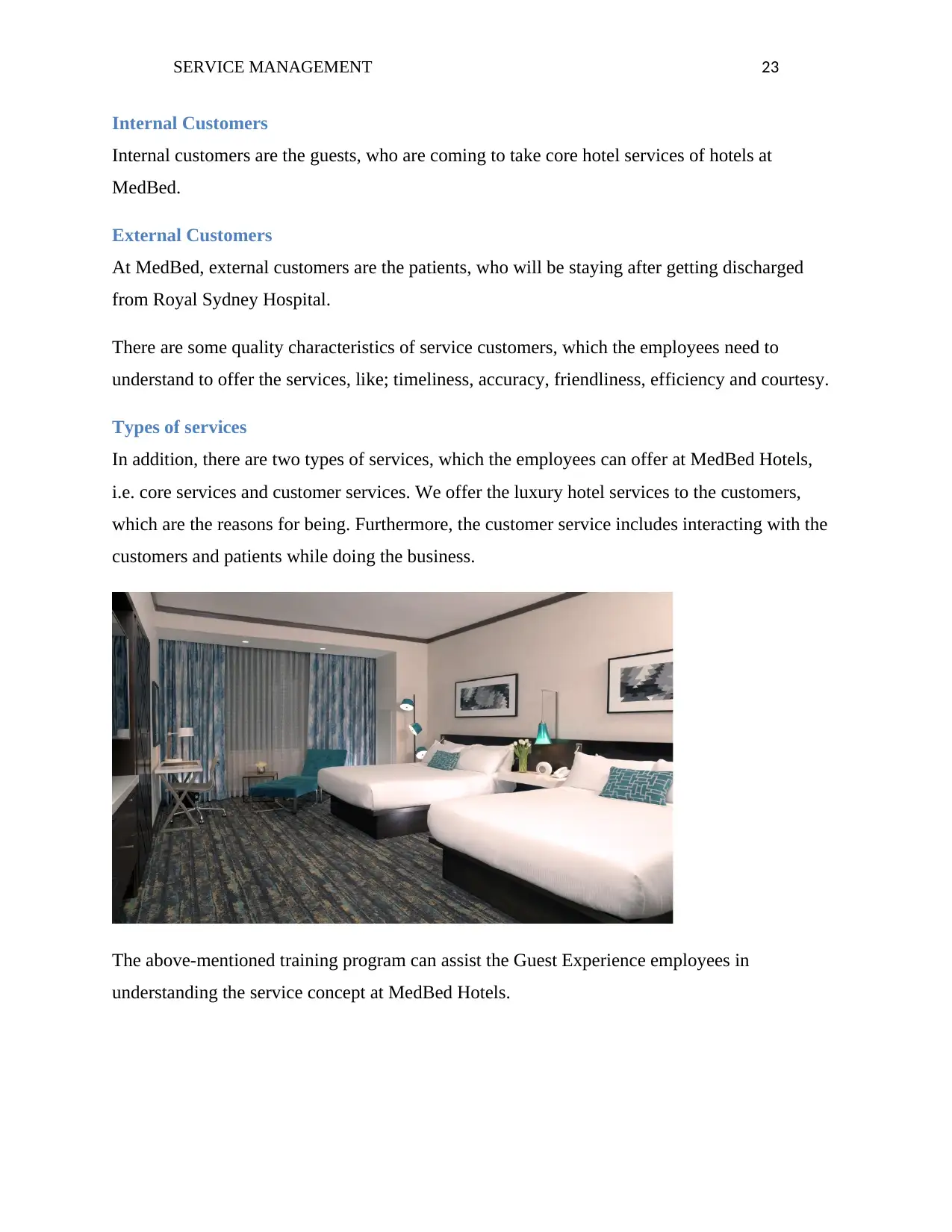
SERVICE MANAGEMENT 23
Internal Customers
Internal customers are the guests, who are coming to take core hotel services of hotels at
MedBed.
External Customers
At MedBed, external customers are the patients, who will be staying after getting discharged
from Royal Sydney Hospital.
There are some quality characteristics of service customers, which the employees need to
understand to offer the services, like; timeliness, accuracy, friendliness, efficiency and courtesy.
Types of services
In addition, there are two types of services, which the employees can offer at MedBed Hotels,
i.e. core services and customer services. We offer the luxury hotel services to the customers,
which are the reasons for being. Furthermore, the customer service includes interacting with the
customers and patients while doing the business.
The above-mentioned training program can assist the Guest Experience employees in
understanding the service concept at MedBed Hotels.
Internal Customers
Internal customers are the guests, who are coming to take core hotel services of hotels at
MedBed.
External Customers
At MedBed, external customers are the patients, who will be staying after getting discharged
from Royal Sydney Hospital.
There are some quality characteristics of service customers, which the employees need to
understand to offer the services, like; timeliness, accuracy, friendliness, efficiency and courtesy.
Types of services
In addition, there are two types of services, which the employees can offer at MedBed Hotels,
i.e. core services and customer services. We offer the luxury hotel services to the customers,
which are the reasons for being. Furthermore, the customer service includes interacting with the
customers and patients while doing the business.
The above-mentioned training program can assist the Guest Experience employees in
understanding the service concept at MedBed Hotels.
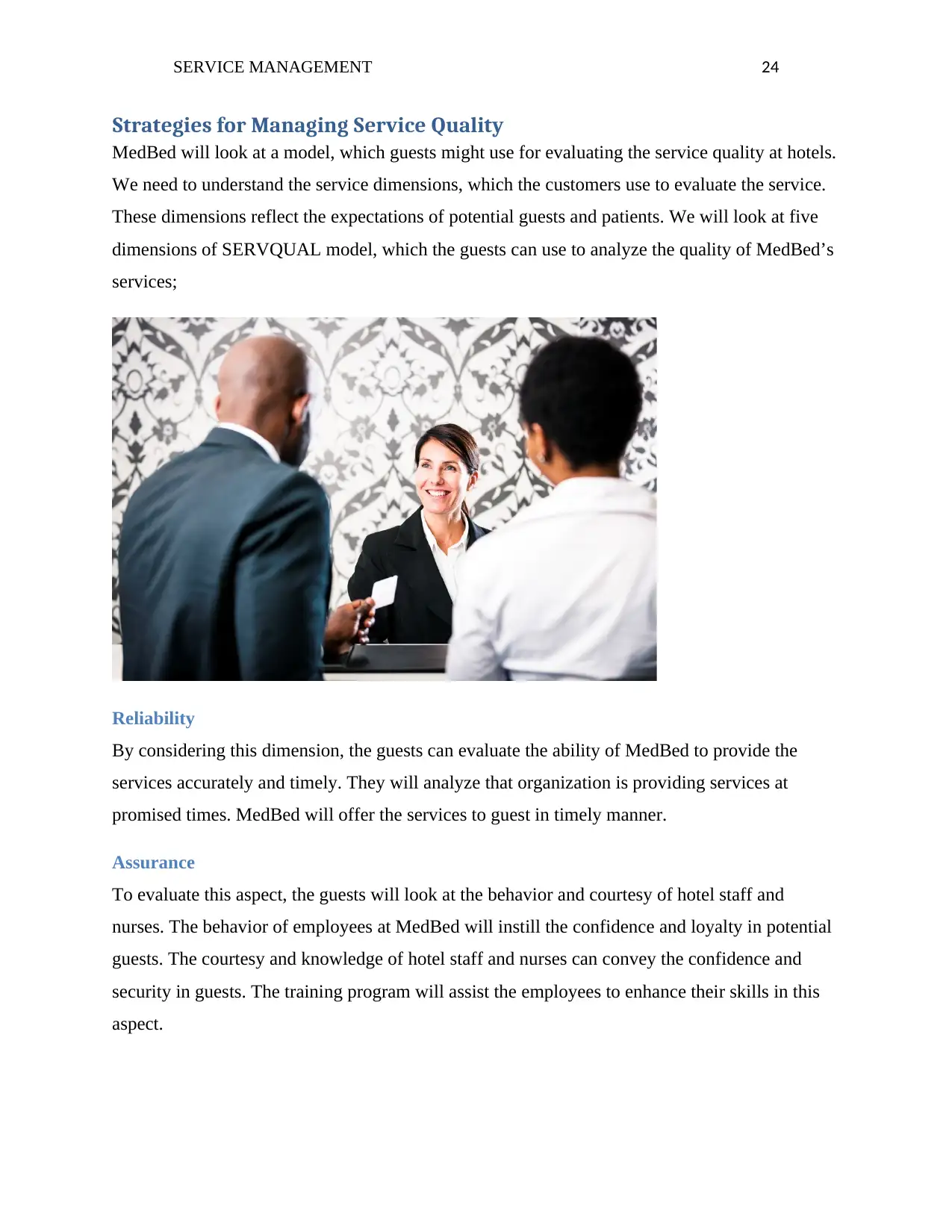
SERVICE MANAGEMENT 24
Strategies for Managing Service Quality
MedBed will look at a model, which guests might use for evaluating the service quality at hotels.
We need to understand the service dimensions, which the customers use to evaluate the service.
These dimensions reflect the expectations of potential guests and patients. We will look at five
dimensions of SERVQUAL model, which the guests can use to analyze the quality of MedBed’s
services;
Reliability
By considering this dimension, the guests can evaluate the ability of MedBed to provide the
services accurately and timely. They will analyze that organization is providing services at
promised times. MedBed will offer the services to guest in timely manner.
Assurance
To evaluate this aspect, the guests will look at the behavior and courtesy of hotel staff and
nurses. The behavior of employees at MedBed will instill the confidence and loyalty in potential
guests. The courtesy and knowledge of hotel staff and nurses can convey the confidence and
security in guests. The training program will assist the employees to enhance their skills in this
aspect.
Strategies for Managing Service Quality
MedBed will look at a model, which guests might use for evaluating the service quality at hotels.
We need to understand the service dimensions, which the customers use to evaluate the service.
These dimensions reflect the expectations of potential guests and patients. We will look at five
dimensions of SERVQUAL model, which the guests can use to analyze the quality of MedBed’s
services;
Reliability
By considering this dimension, the guests can evaluate the ability of MedBed to provide the
services accurately and timely. They will analyze that organization is providing services at
promised times. MedBed will offer the services to guest in timely manner.
Assurance
To evaluate this aspect, the guests will look at the behavior and courtesy of hotel staff and
nurses. The behavior of employees at MedBed will instill the confidence and loyalty in potential
guests. The courtesy and knowledge of hotel staff and nurses can convey the confidence and
security in guests. The training program will assist the employees to enhance their skills in this
aspect.
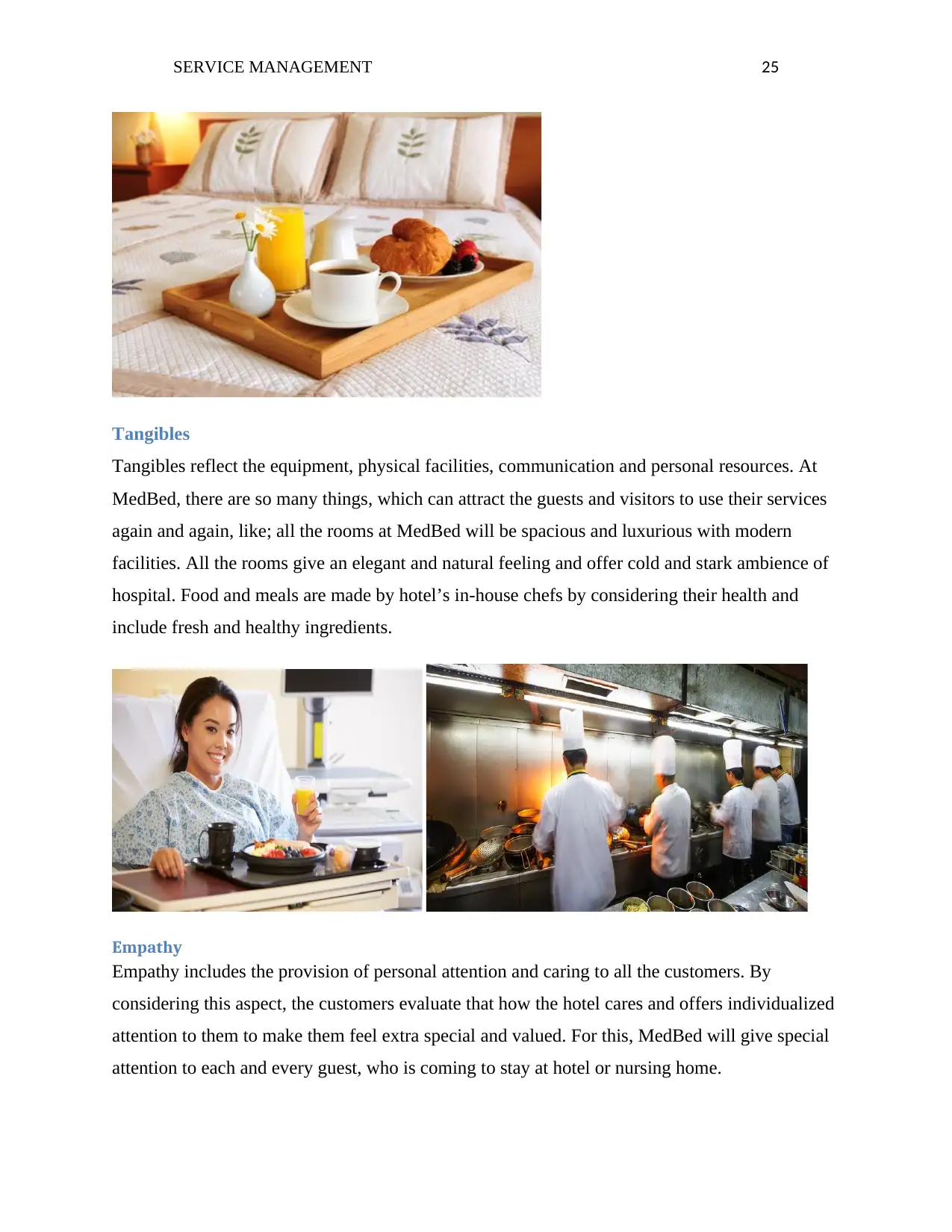
SERVICE MANAGEMENT 25
Tangibles
Tangibles reflect the equipment, physical facilities, communication and personal resources. At
MedBed, there are so many things, which can attract the guests and visitors to use their services
again and again, like; all the rooms at MedBed will be spacious and luxurious with modern
facilities. All the rooms give an elegant and natural feeling and offer cold and stark ambience of
hospital. Food and meals are made by hotel’s in-house chefs by considering their health and
include fresh and healthy ingredients.
Empathy
Empathy includes the provision of personal attention and caring to all the customers. By
considering this aspect, the customers evaluate that how the hotel cares and offers individualized
attention to them to make them feel extra special and valued. For this, MedBed will give special
attention to each and every guest, who is coming to stay at hotel or nursing home.
Tangibles
Tangibles reflect the equipment, physical facilities, communication and personal resources. At
MedBed, there are so many things, which can attract the guests and visitors to use their services
again and again, like; all the rooms at MedBed will be spacious and luxurious with modern
facilities. All the rooms give an elegant and natural feeling and offer cold and stark ambience of
hospital. Food and meals are made by hotel’s in-house chefs by considering their health and
include fresh and healthy ingredients.
Empathy
Empathy includes the provision of personal attention and caring to all the customers. By
considering this aspect, the customers evaluate that how the hotel cares and offers individualized
attention to them to make them feel extra special and valued. For this, MedBed will give special
attention to each and every guest, who is coming to stay at hotel or nursing home.
Paraphrase This Document
Need a fresh take? Get an instant paraphrase of this document with our AI Paraphraser
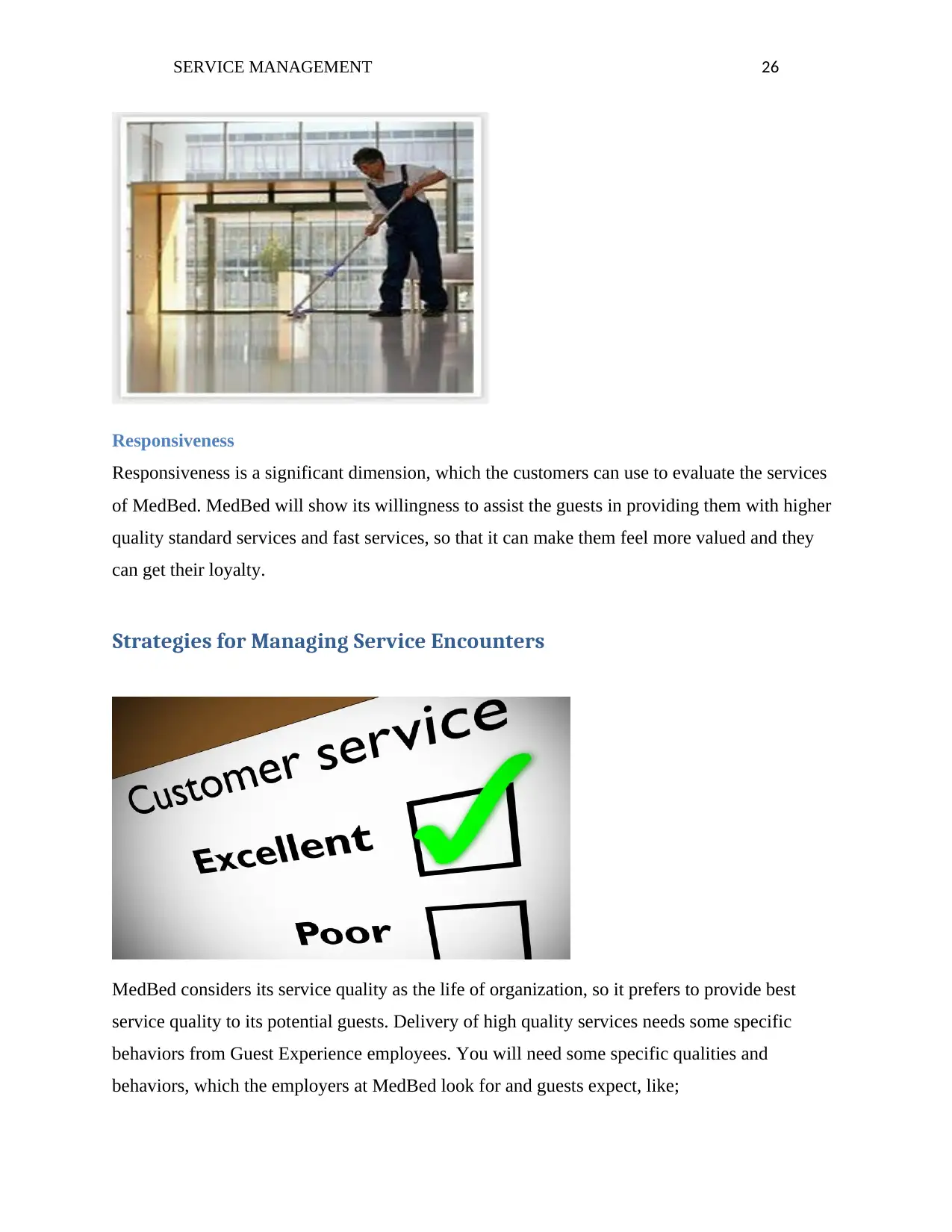
SERVICE MANAGEMENT 26
Responsiveness
Responsiveness is a significant dimension, which the customers can use to evaluate the services
of MedBed. MedBed will show its willingness to assist the guests in providing them with higher
quality standard services and fast services, so that it can make them feel more valued and they
can get their loyalty.
Strategies for Managing Service Encounters
MedBed considers its service quality as the life of organization, so it prefers to provide best
service quality to its potential guests. Delivery of high quality services needs some specific
behaviors from Guest Experience employees. You will need some specific qualities and
behaviors, which the employers at MedBed look for and guests expect, like;
Responsiveness
Responsiveness is a significant dimension, which the customers can use to evaluate the services
of MedBed. MedBed will show its willingness to assist the guests in providing them with higher
quality standard services and fast services, so that it can make them feel more valued and they
can get their loyalty.
Strategies for Managing Service Encounters
MedBed considers its service quality as the life of organization, so it prefers to provide best
service quality to its potential guests. Delivery of high quality services needs some specific
behaviors from Guest Experience employees. You will need some specific qualities and
behaviors, which the employers at MedBed look for and guests expect, like;
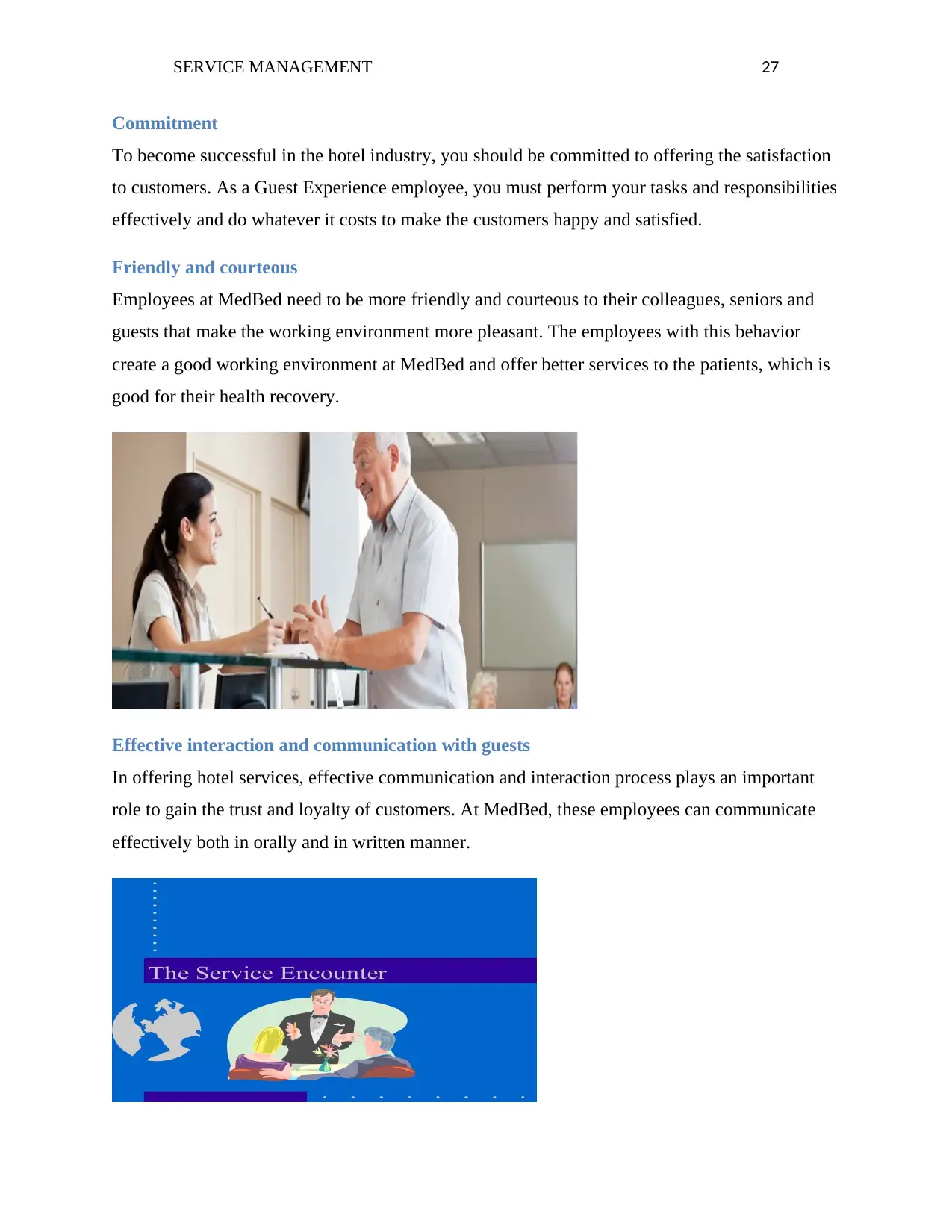
SERVICE MANAGEMENT 27
Commitment
To become successful in the hotel industry, you should be committed to offering the satisfaction
to customers. As a Guest Experience employee, you must perform your tasks and responsibilities
effectively and do whatever it costs to make the customers happy and satisfied.
Friendly and courteous
Employees at MedBed need to be more friendly and courteous to their colleagues, seniors and
guests that make the working environment more pleasant. The employees with this behavior
create a good working environment at MedBed and offer better services to the patients, which is
good for their health recovery.
Effective interaction and communication with guests
In offering hotel services, effective communication and interaction process plays an important
role to gain the trust and loyalty of customers. At MedBed, these employees can communicate
effectively both in orally and in written manner.
Commitment
To become successful in the hotel industry, you should be committed to offering the satisfaction
to customers. As a Guest Experience employee, you must perform your tasks and responsibilities
effectively and do whatever it costs to make the customers happy and satisfied.
Friendly and courteous
Employees at MedBed need to be more friendly and courteous to their colleagues, seniors and
guests that make the working environment more pleasant. The employees with this behavior
create a good working environment at MedBed and offer better services to the patients, which is
good for their health recovery.
Effective interaction and communication with guests
In offering hotel services, effective communication and interaction process plays an important
role to gain the trust and loyalty of customers. At MedBed, these employees can communicate
effectively both in orally and in written manner.
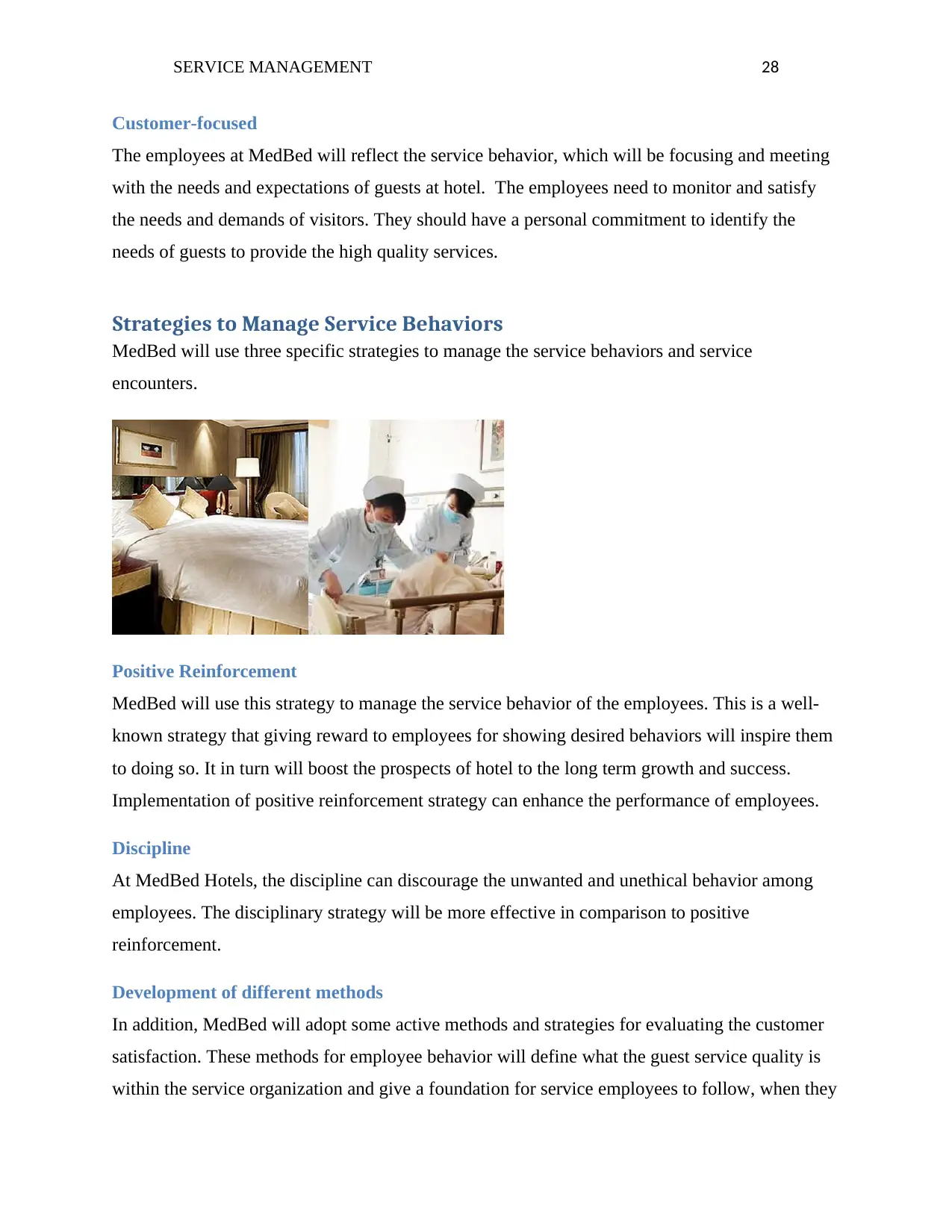
SERVICE MANAGEMENT 28
Customer-focused
The employees at MedBed will reflect the service behavior, which will be focusing and meeting
with the needs and expectations of guests at hotel. The employees need to monitor and satisfy
the needs and demands of visitors. They should have a personal commitment to identify the
needs of guests to provide the high quality services.
Strategies to Manage Service Behaviors
MedBed will use three specific strategies to manage the service behaviors and service
encounters.
Positive Reinforcement
MedBed will use this strategy to manage the service behavior of the employees. This is a well-
known strategy that giving reward to employees for showing desired behaviors will inspire them
to doing so. It in turn will boost the prospects of hotel to the long term growth and success.
Implementation of positive reinforcement strategy can enhance the performance of employees.
Discipline
At MedBed Hotels, the discipline can discourage the unwanted and unethical behavior among
employees. The disciplinary strategy will be more effective in comparison to positive
reinforcement.
Development of different methods
In addition, MedBed will adopt some active methods and strategies for evaluating the customer
satisfaction. These methods for employee behavior will define what the guest service quality is
within the service organization and give a foundation for service employees to follow, when they
Customer-focused
The employees at MedBed will reflect the service behavior, which will be focusing and meeting
with the needs and expectations of guests at hotel. The employees need to monitor and satisfy
the needs and demands of visitors. They should have a personal commitment to identify the
needs of guests to provide the high quality services.
Strategies to Manage Service Behaviors
MedBed will use three specific strategies to manage the service behaviors and service
encounters.
Positive Reinforcement
MedBed will use this strategy to manage the service behavior of the employees. This is a well-
known strategy that giving reward to employees for showing desired behaviors will inspire them
to doing so. It in turn will boost the prospects of hotel to the long term growth and success.
Implementation of positive reinforcement strategy can enhance the performance of employees.
Discipline
At MedBed Hotels, the discipline can discourage the unwanted and unethical behavior among
employees. The disciplinary strategy will be more effective in comparison to positive
reinforcement.
Development of different methods
In addition, MedBed will adopt some active methods and strategies for evaluating the customer
satisfaction. These methods for employee behavior will define what the guest service quality is
within the service organization and give a foundation for service employees to follow, when they
Secure Best Marks with AI Grader
Need help grading? Try our AI Grader for instant feedback on your assignments.
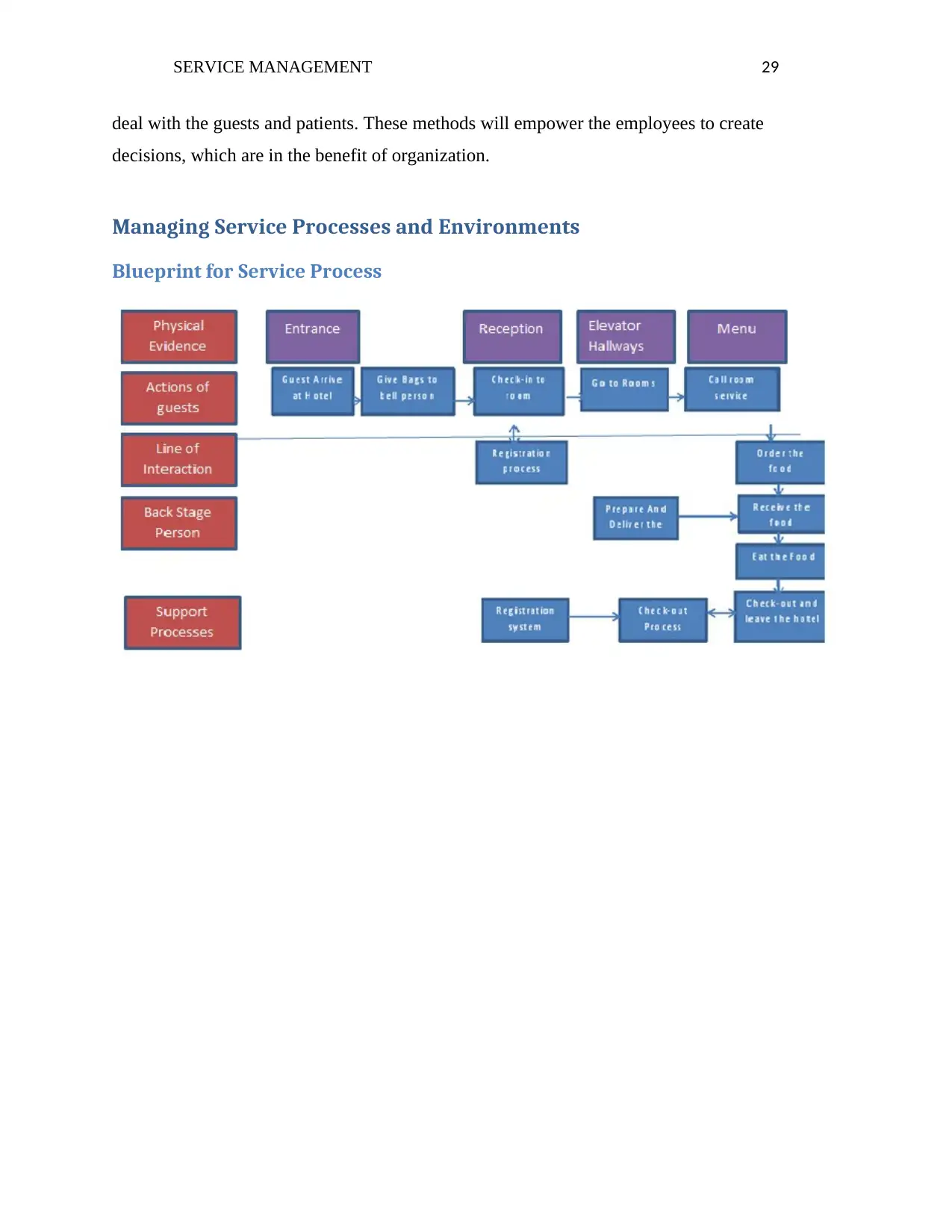
SERVICE MANAGEMENT 29
deal with the guests and patients. These methods will empower the employees to create
decisions, which are in the benefit of organization.
Managing Service Processes and Environments
Blueprint for Service Process
deal with the guests and patients. These methods will empower the employees to create
decisions, which are in the benefit of organization.
Managing Service Processes and Environments
Blueprint for Service Process
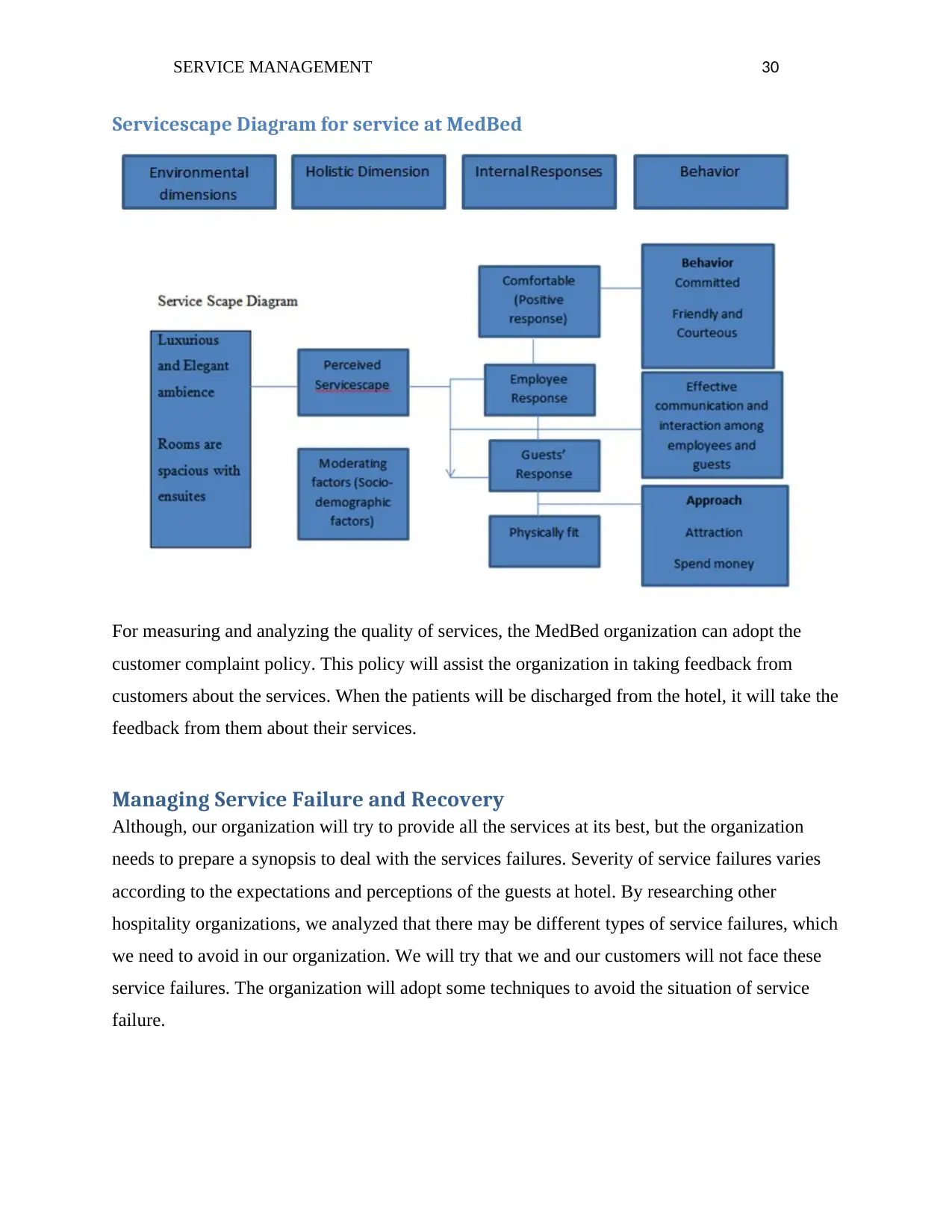
SERVICE MANAGEMENT 30
Servicescape Diagram for service at MedBed
For measuring and analyzing the quality of services, the MedBed organization can adopt the
customer complaint policy. This policy will assist the organization in taking feedback from
customers about the services. When the patients will be discharged from the hotel, it will take the
feedback from them about their services.
Managing Service Failure and Recovery
Although, our organization will try to provide all the services at its best, but the organization
needs to prepare a synopsis to deal with the services failures. Severity of service failures varies
according to the expectations and perceptions of the guests at hotel. By researching other
hospitality organizations, we analyzed that there may be different types of service failures, which
we need to avoid in our organization. We will try that we and our customers will not face these
service failures. The organization will adopt some techniques to avoid the situation of service
failure.
Servicescape Diagram for service at MedBed
For measuring and analyzing the quality of services, the MedBed organization can adopt the
customer complaint policy. This policy will assist the organization in taking feedback from
customers about the services. When the patients will be discharged from the hotel, it will take the
feedback from them about their services.
Managing Service Failure and Recovery
Although, our organization will try to provide all the services at its best, but the organization
needs to prepare a synopsis to deal with the services failures. Severity of service failures varies
according to the expectations and perceptions of the guests at hotel. By researching other
hospitality organizations, we analyzed that there may be different types of service failures, which
we need to avoid in our organization. We will try that we and our customers will not face these
service failures. The organization will adopt some techniques to avoid the situation of service
failure.
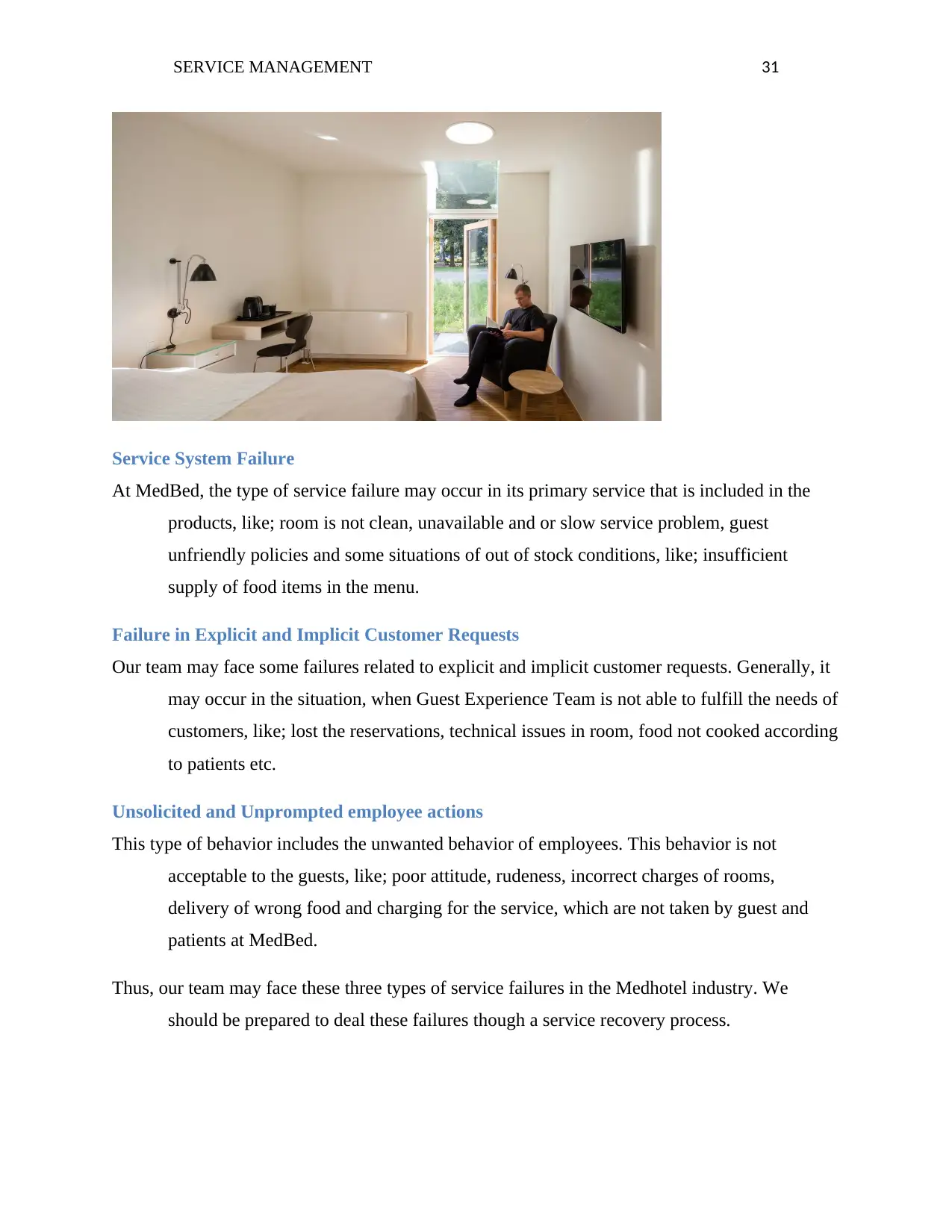
SERVICE MANAGEMENT 31
Service System Failure
At MedBed, the type of service failure may occur in its primary service that is included in the
products, like; room is not clean, unavailable and or slow service problem, guest
unfriendly policies and some situations of out of stock conditions, like; insufficient
supply of food items in the menu.
Failure in Explicit and Implicit Customer Requests
Our team may face some failures related to explicit and implicit customer requests. Generally, it
may occur in the situation, when Guest Experience Team is not able to fulfill the needs of
customers, like; lost the reservations, technical issues in room, food not cooked according
to patients etc.
Unsolicited and Unprompted employee actions
This type of behavior includes the unwanted behavior of employees. This behavior is not
acceptable to the guests, like; poor attitude, rudeness, incorrect charges of rooms,
delivery of wrong food and charging for the service, which are not taken by guest and
patients at MedBed.
Thus, our team may face these three types of service failures in the Medhotel industry. We
should be prepared to deal these failures though a service recovery process.
Service System Failure
At MedBed, the type of service failure may occur in its primary service that is included in the
products, like; room is not clean, unavailable and or slow service problem, guest
unfriendly policies and some situations of out of stock conditions, like; insufficient
supply of food items in the menu.
Failure in Explicit and Implicit Customer Requests
Our team may face some failures related to explicit and implicit customer requests. Generally, it
may occur in the situation, when Guest Experience Team is not able to fulfill the needs of
customers, like; lost the reservations, technical issues in room, food not cooked according
to patients etc.
Unsolicited and Unprompted employee actions
This type of behavior includes the unwanted behavior of employees. This behavior is not
acceptable to the guests, like; poor attitude, rudeness, incorrect charges of rooms,
delivery of wrong food and charging for the service, which are not taken by guest and
patients at MedBed.
Thus, our team may face these three types of service failures in the Medhotel industry. We
should be prepared to deal these failures though a service recovery process.
Paraphrase This Document
Need a fresh take? Get an instant paraphrase of this document with our AI Paraphraser
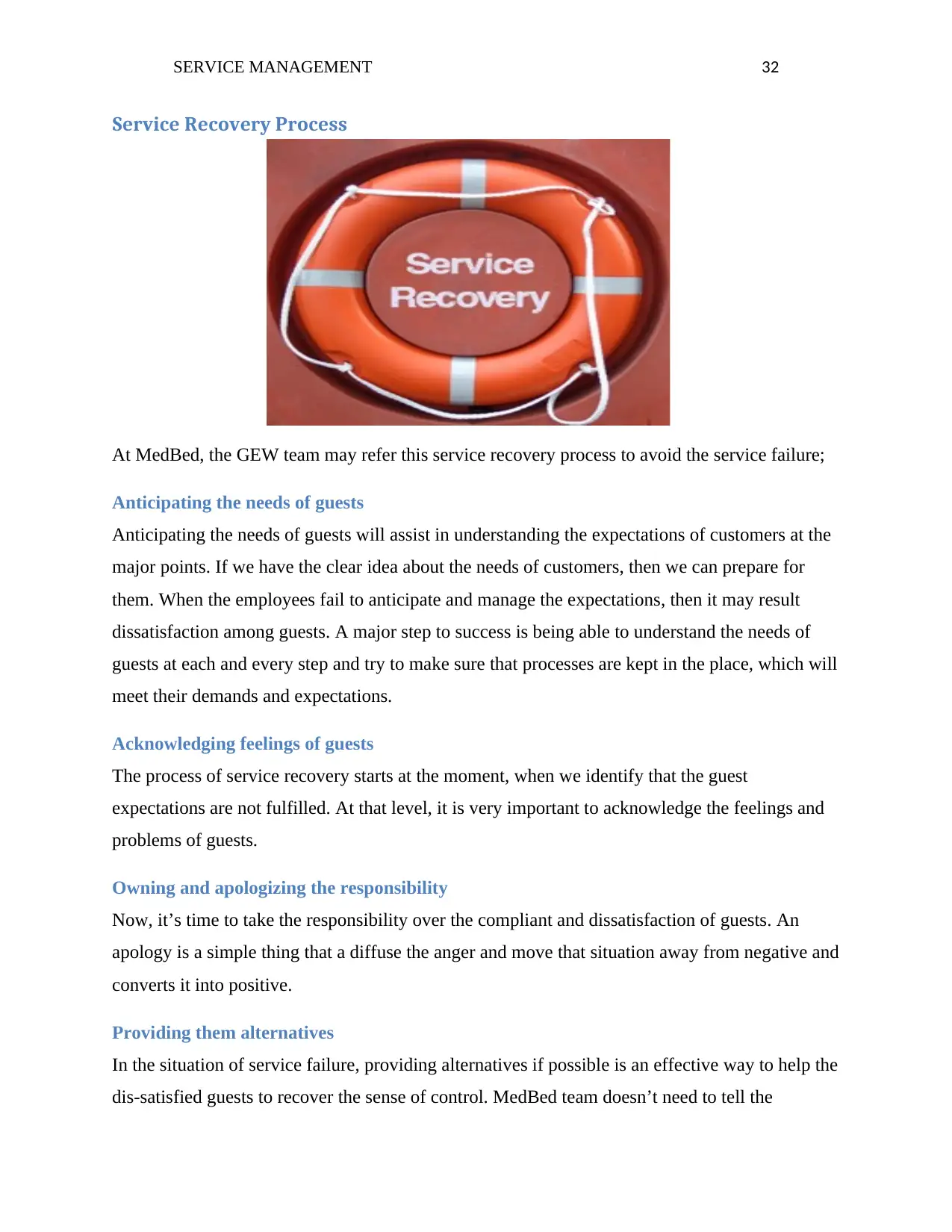
SERVICE MANAGEMENT 32
Service Recovery Process
At MedBed, the GEW team may refer this service recovery process to avoid the service failure;
Anticipating the needs of guests
Anticipating the needs of guests will assist in understanding the expectations of customers at the
major points. If we have the clear idea about the needs of customers, then we can prepare for
them. When the employees fail to anticipate and manage the expectations, then it may result
dissatisfaction among guests. A major step to success is being able to understand the needs of
guests at each and every step and try to make sure that processes are kept in the place, which will
meet their demands and expectations.
Acknowledging feelings of guests
The process of service recovery starts at the moment, when we identify that the guest
expectations are not fulfilled. At that level, it is very important to acknowledge the feelings and
problems of guests.
Owning and apologizing the responsibility
Now, it’s time to take the responsibility over the compliant and dissatisfaction of guests. An
apology is a simple thing that a diffuse the anger and move that situation away from negative and
converts it into positive.
Providing them alternatives
In the situation of service failure, providing alternatives if possible is an effective way to help the
dis-satisfied guests to recover the sense of control. MedBed team doesn’t need to tell the
Service Recovery Process
At MedBed, the GEW team may refer this service recovery process to avoid the service failure;
Anticipating the needs of guests
Anticipating the needs of guests will assist in understanding the expectations of customers at the
major points. If we have the clear idea about the needs of customers, then we can prepare for
them. When the employees fail to anticipate and manage the expectations, then it may result
dissatisfaction among guests. A major step to success is being able to understand the needs of
guests at each and every step and try to make sure that processes are kept in the place, which will
meet their demands and expectations.
Acknowledging feelings of guests
The process of service recovery starts at the moment, when we identify that the guest
expectations are not fulfilled. At that level, it is very important to acknowledge the feelings and
problems of guests.
Owning and apologizing the responsibility
Now, it’s time to take the responsibility over the compliant and dissatisfaction of guests. An
apology is a simple thing that a diffuse the anger and move that situation away from negative and
converts it into positive.
Providing them alternatives
In the situation of service failure, providing alternatives if possible is an effective way to help the
dis-satisfied guests to recover the sense of control. MedBed team doesn’t need to tell the
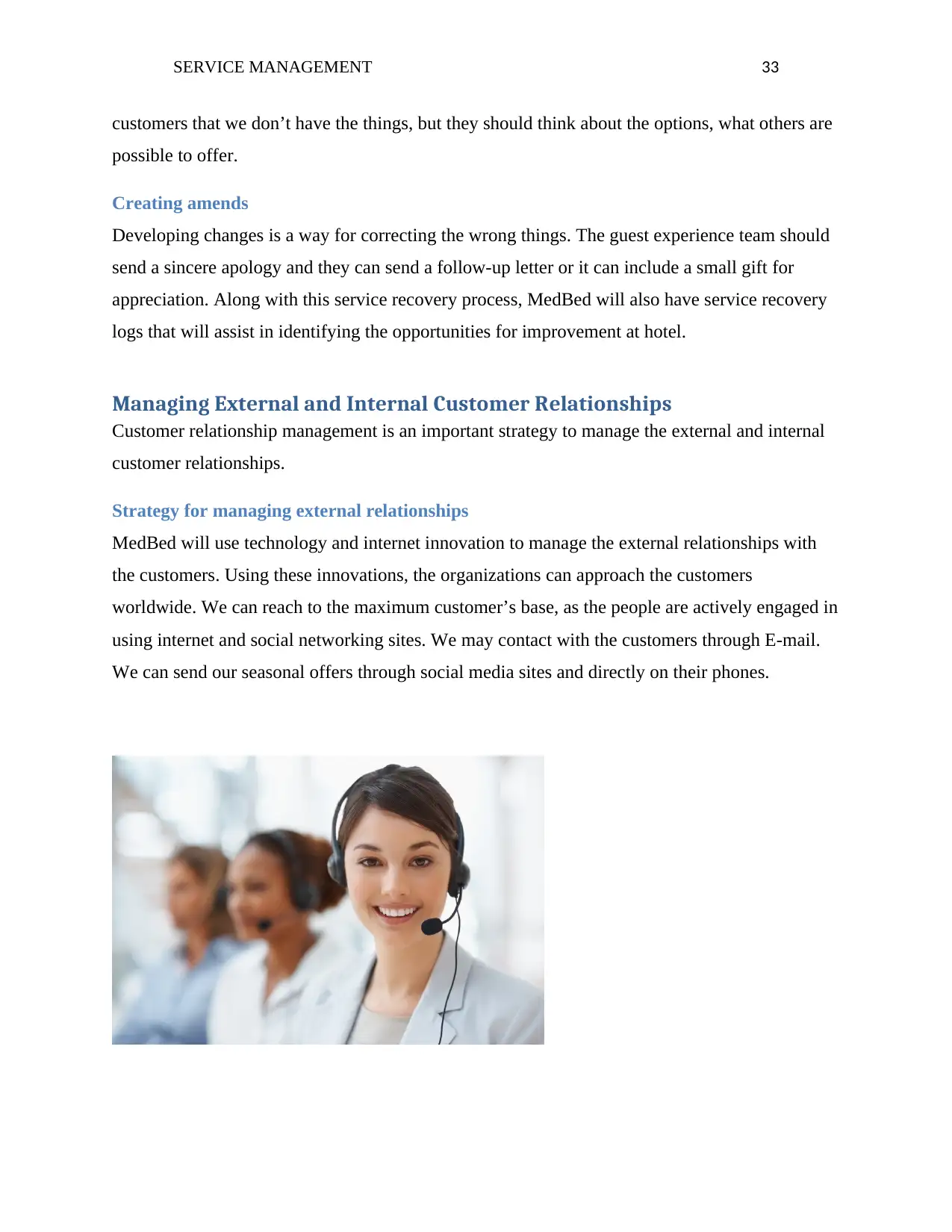
SERVICE MANAGEMENT 33
customers that we don’t have the things, but they should think about the options, what others are
possible to offer.
Creating amends
Developing changes is a way for correcting the wrong things. The guest experience team should
send a sincere apology and they can send a follow-up letter or it can include a small gift for
appreciation. Along with this service recovery process, MedBed will also have service recovery
logs that will assist in identifying the opportunities for improvement at hotel.
Managing External and Internal Customer Relationships
Customer relationship management is an important strategy to manage the external and internal
customer relationships.
Strategy for managing external relationships
MedBed will use technology and internet innovation to manage the external relationships with
the customers. Using these innovations, the organizations can approach the customers
worldwide. We can reach to the maximum customer’s base, as the people are actively engaged in
using internet and social networking sites. We may contact with the customers through E-mail.
We can send our seasonal offers through social media sites and directly on their phones.
customers that we don’t have the things, but they should think about the options, what others are
possible to offer.
Creating amends
Developing changes is a way for correcting the wrong things. The guest experience team should
send a sincere apology and they can send a follow-up letter or it can include a small gift for
appreciation. Along with this service recovery process, MedBed will also have service recovery
logs that will assist in identifying the opportunities for improvement at hotel.
Managing External and Internal Customer Relationships
Customer relationship management is an important strategy to manage the external and internal
customer relationships.
Strategy for managing external relationships
MedBed will use technology and internet innovation to manage the external relationships with
the customers. Using these innovations, the organizations can approach the customers
worldwide. We can reach to the maximum customer’s base, as the people are actively engaged in
using internet and social networking sites. We may contact with the customers through E-mail.
We can send our seasonal offers through social media sites and directly on their phones.
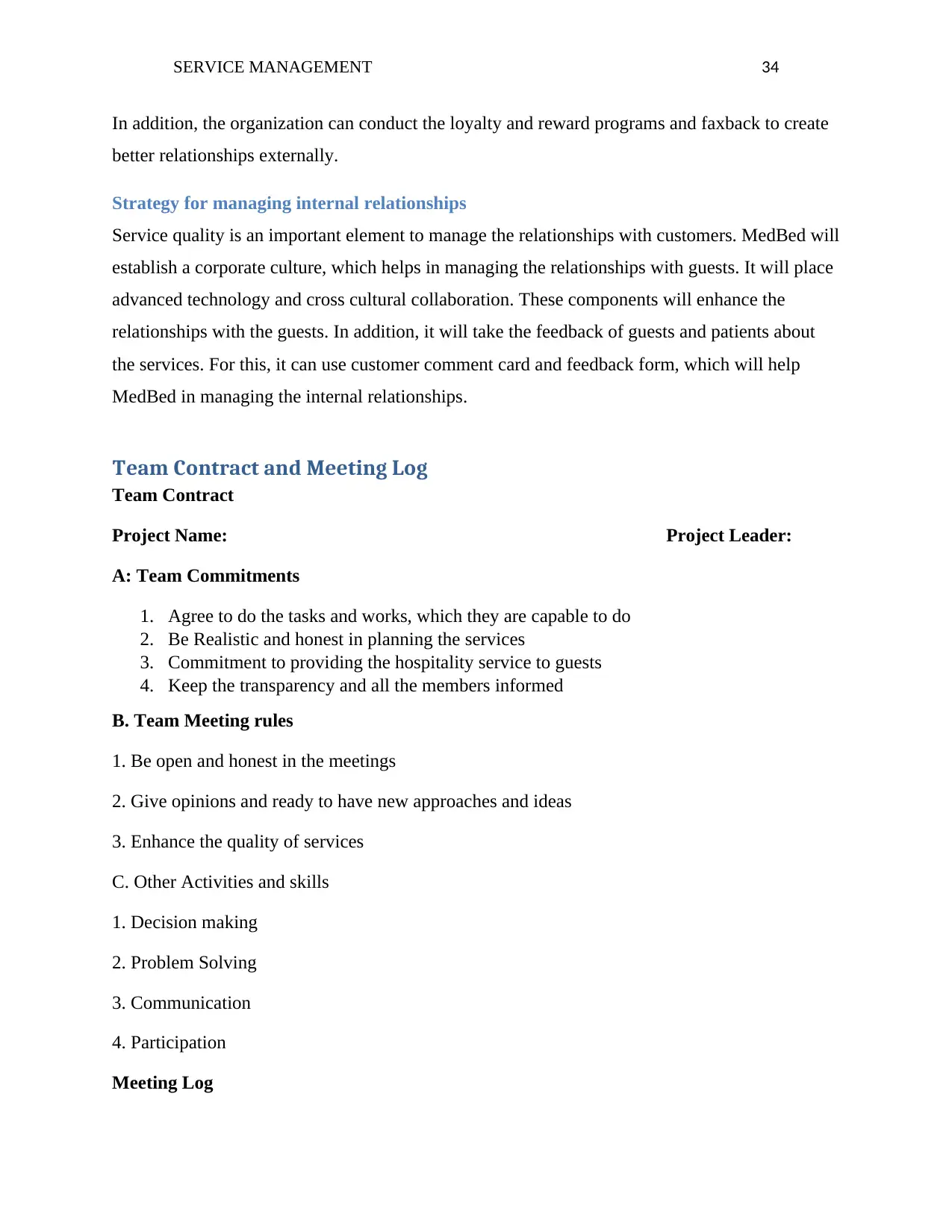
SERVICE MANAGEMENT 34
In addition, the organization can conduct the loyalty and reward programs and faxback to create
better relationships externally.
Strategy for managing internal relationships
Service quality is an important element to manage the relationships with customers. MedBed will
establish a corporate culture, which helps in managing the relationships with guests. It will place
advanced technology and cross cultural collaboration. These components will enhance the
relationships with the guests. In addition, it will take the feedback of guests and patients about
the services. For this, it can use customer comment card and feedback form, which will help
MedBed in managing the internal relationships.
Team Contract and Meeting Log
Team Contract
Project Name: Project Leader:
A: Team Commitments
1. Agree to do the tasks and works, which they are capable to do
2. Be Realistic and honest in planning the services
3. Commitment to providing the hospitality service to guests
4. Keep the transparency and all the members informed
B. Team Meeting rules
1. Be open and honest in the meetings
2. Give opinions and ready to have new approaches and ideas
3. Enhance the quality of services
C. Other Activities and skills
1. Decision making
2. Problem Solving
3. Communication
4. Participation
Meeting Log
In addition, the organization can conduct the loyalty and reward programs and faxback to create
better relationships externally.
Strategy for managing internal relationships
Service quality is an important element to manage the relationships with customers. MedBed will
establish a corporate culture, which helps in managing the relationships with guests. It will place
advanced technology and cross cultural collaboration. These components will enhance the
relationships with the guests. In addition, it will take the feedback of guests and patients about
the services. For this, it can use customer comment card and feedback form, which will help
MedBed in managing the internal relationships.
Team Contract and Meeting Log
Team Contract
Project Name: Project Leader:
A: Team Commitments
1. Agree to do the tasks and works, which they are capable to do
2. Be Realistic and honest in planning the services
3. Commitment to providing the hospitality service to guests
4. Keep the transparency and all the members informed
B. Team Meeting rules
1. Be open and honest in the meetings
2. Give opinions and ready to have new approaches and ideas
3. Enhance the quality of services
C. Other Activities and skills
1. Decision making
2. Problem Solving
3. Communication
4. Participation
Meeting Log
Secure Best Marks with AI Grader
Need help grading? Try our AI Grader for instant feedback on your assignments.
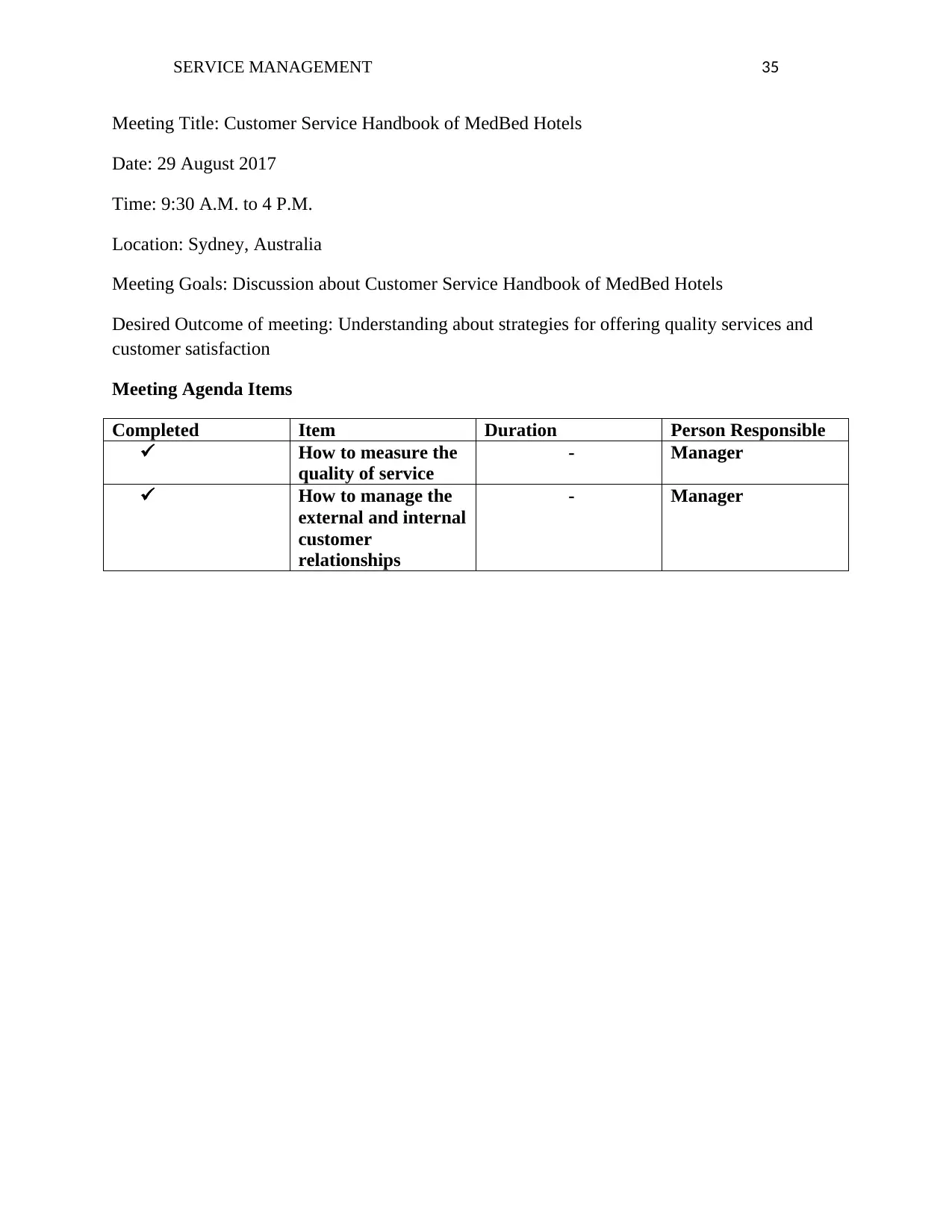
SERVICE MANAGEMENT 35
Meeting Title: Customer Service Handbook of MedBed Hotels
Date: 29 August 2017
Time: 9:30 A.M. to 4 P.M.
Location: Sydney, Australia
Meeting Goals: Discussion about Customer Service Handbook of MedBed Hotels
Desired Outcome of meeting: Understanding about strategies for offering quality services and
customer satisfaction
Meeting Agenda Items
Completed Item Duration Person Responsible
How to measure the
quality of service
- Manager
How to manage the
external and internal
customer
relationships
- Manager
Meeting Title: Customer Service Handbook of MedBed Hotels
Date: 29 August 2017
Time: 9:30 A.M. to 4 P.M.
Location: Sydney, Australia
Meeting Goals: Discussion about Customer Service Handbook of MedBed Hotels
Desired Outcome of meeting: Understanding about strategies for offering quality services and
customer satisfaction
Meeting Agenda Items
Completed Item Duration Person Responsible
How to measure the
quality of service
- Manager
How to manage the
external and internal
customer
relationships
- Manager
1 out of 35
Related Documents
Your All-in-One AI-Powered Toolkit for Academic Success.
+13062052269
info@desklib.com
Available 24*7 on WhatsApp / Email
![[object Object]](/_next/static/media/star-bottom.7253800d.svg)
Unlock your academic potential
© 2024 | Zucol Services PVT LTD | All rights reserved.




